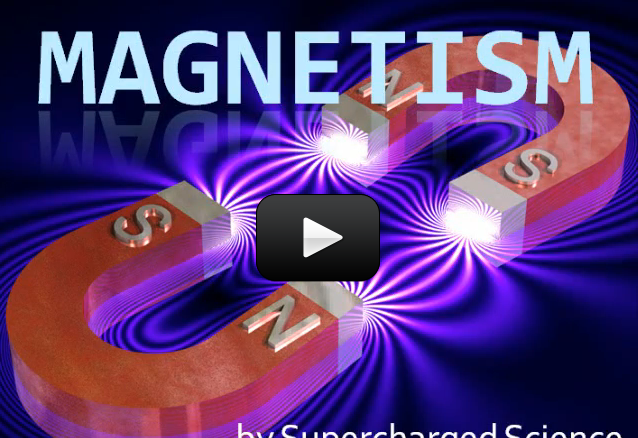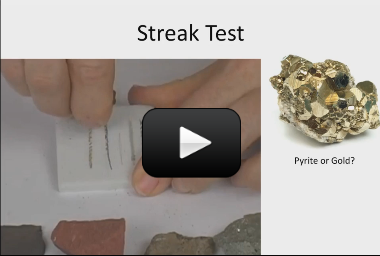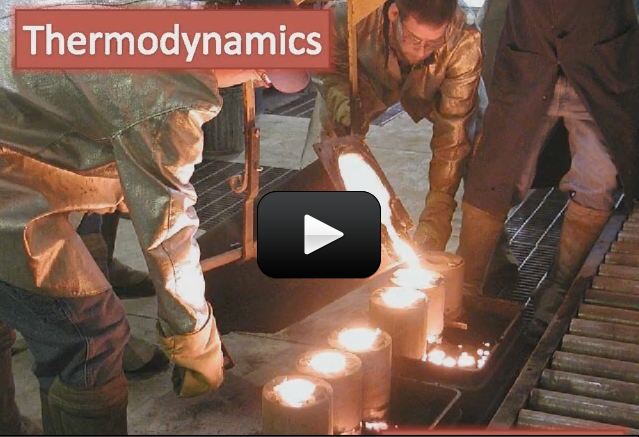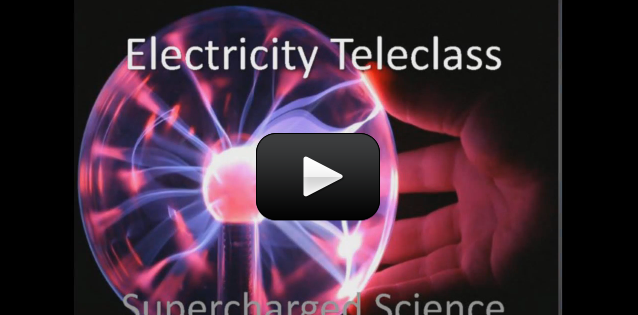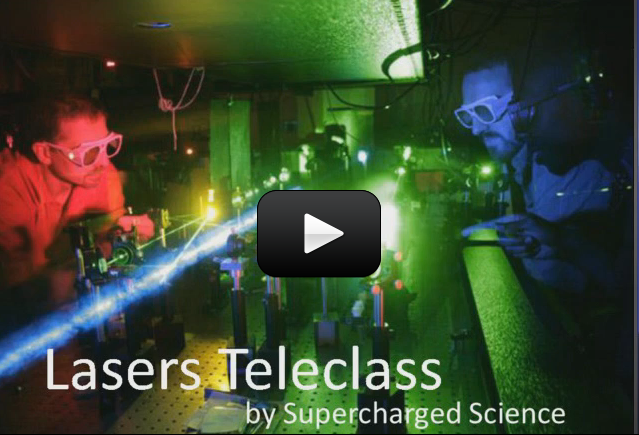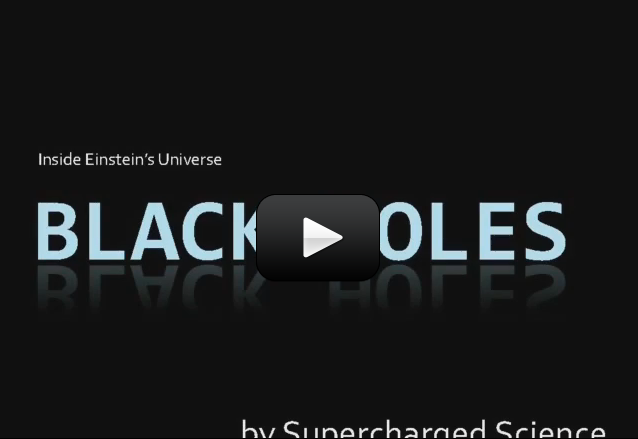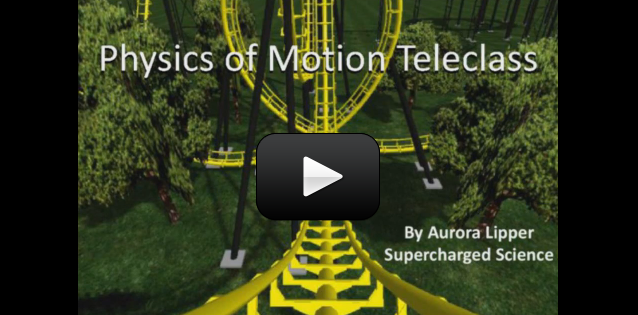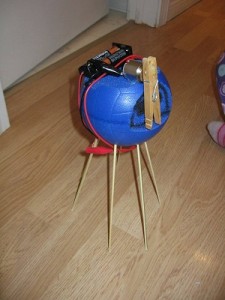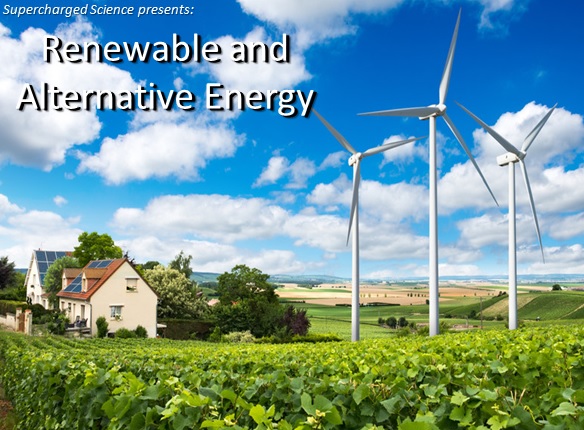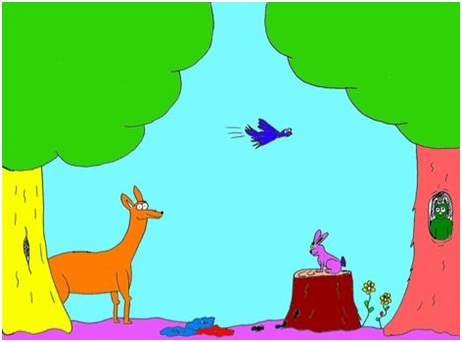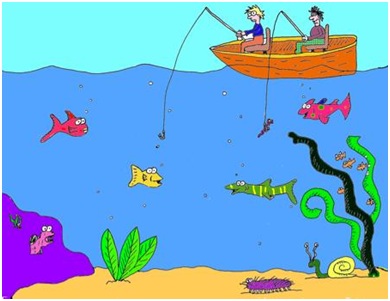Discover how to detect magnetic fields, learn about the Earth's 8 magnetic poles, and uncover the mysterious link between electricity and magnetism that marks one of the biggest discoveries of all science…ever.
Materials:
- Box of paperclips
- Two magnets (make sure one of them ceramic because we're going to break it)
- Compass
- Hammer
- Nail
- Sandpaper or nail file
- D cell battery
- Rubber band
- Magnet Wire
- Nine ½” (12 mm) ball bearings
- Toilet paper tube or paper towel tube
- Ruler with groove down the middle
- Eight strong rubber bands
- Scissors
[am4show have='p8;p9;p11;p38;p97;' guest_error='Guest error message' user_error='User error message' ]
Key Concepts
While the kids are playing with the experiments see if you can get them to notice these important ideas. When they can explain these concepts back to you (in their own words or with demonstrations), you’ll know that they’ve mastered the lesson.Magnets
- Magnetic fields are created by electrons moving in the same direction. Electrons can have a “left” or “right” spin. If an atom has more electrons spinning in one direction than in the other, that atom has a magnetic field.
- If an object is filled with atoms that have an abundance of electrons spinning in the same direction, and if those atoms are lined up in the same direction, that object will have a magnetic force.
- A field is an area around an electrical, magnetic or gravitational source that will create a force on another electrical, magnetic or gravitational source that comes within the reach of the field.
- In fields, the closer something gets to the source of the field, the stronger the force of the field gets. This is called the inverse square law.
- A magnetic field must come from a north pole of a magnet and go to a south pole of a magnet (or atoms that have turned to the magnetic field.)
- All magnets have two poles. Magnets are called dipolar which means they have two poles. The two poles of a magnet are called north and south poles. The magnetic field comes from a north pole and goes to a south pole. Opposite poles will attract one another. Like poles will repel one another.
- Iron and a few other types of atoms will turn to align themselves with the magnetic field. Over time iron atoms will align themselves with the force of the magnetic field.
- The Earth has a huge magnetic field. The Earth has a weak magnetic force. The magnetic field comes from the moving electrons in the currents of the Earth’s molten core. The Earth has a north and a south magnetic pole which is different from the geographic north and south pole.
- Compasses turn with the force of the magnetic field.
- Electricity is moving electrons. Magnetism is caused by moving electrons. Electricity causes magnetism.
- Magnetic fields can cause electricity.
What's Going On?
The scientific principles we’re going to cover were first discovered by a host of scientists in the 19th century, each working on the ideas from each other, most prominently James Maxwell. This is one of the most exciting areas of science, because it includes one of the most important scientific discoveries of all time: how electricity and magnetism are connected. Before this discovery, people thought of electricity and magnetism as two separate things. When scientists realized that not only were they linked together, but that one causes the other, that’s when the field of physics really took off.Questions
When you’ve worked through most of the experiments ask your kids these questions and see how they do:- How many poles do magnets have, and what are they?
- What happens when you bring two like poles together?
- How do I know which pole is which on a magnet?
- Is the magnetic force stronger or weaker the closer a magnet gets to another magnet?
- What kinds of materials are magnets made from?
- Name three objects that stick to a magnet.
- Name three that don’t stick to a magnet.
- What does a compass detect? How do you know when it’s detected it?
- How many poles do magnets have, and what are they? Two. North and South poles.
- What happens when you bring two like poles together? They repel each other.
- How do I know which pole is which on a magnet? Put two magnets together and find the spot where they are repelling the strongest. The poles facing each other are the same. Or bring it close to a compass. If the magnet attracts the needle to north, then the magnet’s pole is the south pole.
- Is the magnetic force stronger or weaker the closer a magnet gets to another magnet? Stronger.
- What kinds of materials are magnets made from? Iron, nickel and cobalt.
- Name three objects that stick to a magnet. Paperclips, pipe cleaners, and staples.
- Name three that don’t stick to a magnet. US quarter, glass, plastic.
- What does a compass detect? How do you know when it’s detected it? The direction of a magnetic field. When the needle is deflected, the compass is in a magnetic field.
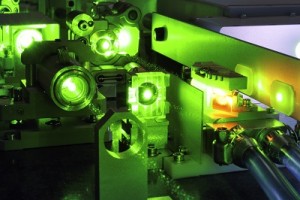 Doing science is exciting, fun, and full of big ideas! Why bother with writing when you could be mixing up chemicals, blasting rockets, or shattering laser beams?
Doing science is exciting, fun, and full of big ideas! Why bother with writing when you could be mixing up chemicals, blasting rockets, or shattering laser beams?Because all your "great ideas" are worth nothing if you can't tell others about what you're doing. Scientists write in journals to let others know the latest news with their experiments, announce their new discoveries, or to simply keep track of their progress.
You don't have to write a novel - just keep track of what you're doing along with any questions that come up. It's a lot easier to do a couple pages a day for a month rather than trying to pound out a hundred pages in a day! This is something you're going to use throughout the program doing just a little bit at a time, At the end of the month or year, you'll be surprised to see how much science you've covered!
There are three simple steps to this process:
Grab, Title, and Record
Step 1:Grab a notebook.
You don't need a fancy quad-ruled, glossy bound, gold-letter-embossed notebook, either. Just find a regular spiral-bound notebook from the store and scribble your child's name across the top. (You can even staple ten blank pages together and call it a notebook if you really want to.)
Step 2: Title the top of a fresh page with the name of the lesson or experiment.
For example, from Unit 1, you'd write: Gravity. Easy so far, right? Add the date and time to the top corner and number your pages (in case you need to reference them later on. Trust me - it's a lot easier to number as you go).Step 3: Record by describing what you're doing.
 If you're reading about gravity, jot down a few notes about what you picked up. This is where you want to capture your Ah-HA! moments. If getting your child to write is harder than changing a car transmission in a snowstorm, then grab a video camera and record them as they work and talk their way through the experiment. Just have them describe what they are doing as they do it (you can probe them along with questions if they get stuck for words). For shyer kids, don't have them look at the camera - in fact, if you focus the camera only on their hands as they work through an experiment, their shyness usually will vanish.
If you're reading about gravity, jot down a few notes about what you picked up. This is where you want to capture your Ah-HA! moments. If getting your child to write is harder than changing a car transmission in a snowstorm, then grab a video camera and record them as they work and talk their way through the experiment. Just have them describe what they are doing as they do it (you can probe them along with questions if they get stuck for words). For shyer kids, don't have them look at the camera - in fact, if you focus the camera only on their hands as they work through an experiment, their shyness usually will vanish.A lot of scientists and engineers carry around a voice recorder, so when they have a GREAT IDEA, they can quickly capture it with words by hitting the 'record' button (even while driving!). This allows them to quickly capture and talk about the idea without fussing with the slowness of a pencil and paper. They later play it back and jot down notes and expand it when they have more time.
If you love to write and draw, simply write down the experiment or reading bullet points and illustrate with pictures, describing it with real words that make sense to you. Don't worry about it not being 'formal' or 'correct' - this is your journal, not for anyone else.
For example, if you're launching the potato cannon (which we'll actually be doing later on), and you finally figured out how it worked, we'd rather see you write: "I shoved the stick in, which squashed the air, and POP!"
instead of "...as the lowermost potato slug was moved in an upward direction, the pressure increased as the volume decreased until the structural integrity of the uppermost potato was breached, at which time the..." Use words that really speak to you in your own terms. You are not writing a textbook, but rather capturing the essence of the experience you're having as you learn science. Got it?
 Also, if you have any questions that pop up along the way (especially ones that require more time to search for the answers), write them down here as well. Highlight or *star* each question so you remember to go back and get them answered when you have more time.
Also, if you have any questions that pop up along the way (especially ones that require more time to search for the answers), write them down here as well. Highlight or *star* each question so you remember to go back and get them answered when you have more time.If you're recording your progress on a science experiment, get your picture taken as you are doing the experiment and paste it in the notebook. Add a caption about what you are doing, what you found, etc. Most scientists will also record any data they took for the experiment alongside the picture of their set up so it's all in one place.
An excellent idea many families have reported using is at the end of the unit, the parents will become the student and the kids teach the lesson back to the parent until the parent gets it. This may take a bit of work of the kid's part, but most of the time, you'll find kids are determined and creative at getting their point across because they are so excited and passionate about what they have just learned. (Don't believe us? Try faking ignorance and see what your child comes up with.)
And that's it! Do you think this is something you can do?
If so, you've just boosted yourself to the top 10% of the students worldwide that actually take the time to capture and record their work. If you just hear or read something only one time, you will only remember 12% of it after about a week. However, when you capture and record notes about what you're doing, the retention after a week shoots up to over 65%. When you take it one step further and teach it to others, you're now over 85% retention after the first month.Turning your Science Journal into Homework You Can Hand In
Once you've mastered the basic steps to keeping a science journal, you can easily match it with your state's requirements for science, provide it as a writing sample with your college application (especially if it contains photos of you taking data), or show it it to your adviser.
Your experiments aren't going to be useful if you can't tell other people about it. There's a standard format that most scientists follow, and that's what we're going to cover here. When you practice these essential steps, your child will be light-years ahead of the game when they hit college. Your kids will not just know the steps on an intellectual level, but it will become built into their nervous system through habit and be a guide as they work through their homework for years to come.
Writing a Rock-Solid Science Journal Report
Once you've gotten into the habit of Grab, Title, and Record, now it's time to put a little more structure into the 'Record' section. I'm going to share with you how we teach engineering students to keep their lab books at the University. This is the same techniques used by astronomers, automotive designers, nuclear engineers, and NASA scientists.When you use this approach when working through the activities, projects, and experiments in the eScience program, you will have a rock-solid documentation that will pass any curriculum adviser, college-entrance examiner, or state required documentation. And it will be organized, easy to use, and rewarding to flip through years later.
Writing a Rock-Solid Science Journal Report
Step 1: Title
Effects of Antenna Wire Length on Crystal Radio Reception Aurora Lipper November 23, 2010
Step 2: Introduction (Purpose)
Step 3: Materials
- Toilet paper tube
- Magnet wire
- Germanium diode (1N34A)
- Telephone handset or get a crystal earphone
- Alligator clip test leads
- 100’ stranded insulated wire (for the antenna)
- Camera to document project
- Composition or spiral-bound notebook to take notes
- Display board (the three-panel kind with wings), about 48” wide by 36” tall
- Paper for the printer (and photo paper for printing out your photos from the camera)
- Computer and printer
Step 4: Procedure
Step 5: Results
| Crystal Radio Data Sheet | |||
| Name | Aurora Lipper | Antenna wire gauge | 24g |
| Date | Nov. 28, 2009 | Tube wire gauge | 28g magnet |
| Time | 12:45pm | Diode type | germanium |
| Trial # | Antenna Length | Signal Strength | |
| (feet) | (Min = 1, Max =5) | ||
| 1 | 10 | 1 | |
| 2 | 20 | 2 | |
| 3 | 30 | 2 | |
| 4 | 40 | 3 | |
| 5 | 50 | 4 | |
| 6 | 60 | 4.5 | |
| 7 | 70 | 5 | |
| 8 | 80 | 5 | |
| 9 | 90 | 5 | |
| 10 | 100 | 5 | |
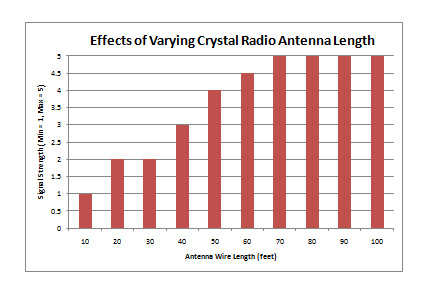
|
Step 6: Conclusion
Step 7: References
Whew! So to recap...
 Step 1: Title: Effects of Antenna Wire Length on Crystal Radio Reception, by Aurora Lipper, November 23, 2010. This goes at the top of the page.
Step 1: Title: Effects of Antenna Wire Length on Crystal Radio Reception, by Aurora Lipper, November 23, 2010. This goes at the top of the page. Tips & Tricks & Bonus Ideas!
This is a recording of a recent live teleclass I did with thousands of kids from all over the world. I’ve included it here so you can participate and learn, too!
This class is all about Biology, what it is and how it works. If you love plants, animals, insects, and strange puzzling challenges, then this is the area of science for you. We’re about to see and do the kind of science that was not in your typical textbooks. Without biology, there would be no cure for diseases, we wouldn’t understand which foods are the right ones to eat, why we have to brush our teeth and wash our hands, which water we can drink without getting sick, athletes couldn’t figure out how to improve their performance. It helps us understand how life works so we can make the most effective use of that information, like how to clean up our environment or grow better crops without exhausting the soil.
Materials:
- Salt
- Clear glass cup
- Coffee filter and a funnel
- Isopropyl alcohol (91%) – COLD!
- Blender or food processor
- Liquid dishwashing detergent
- A fruit or vegetable
- 2 handheld magnifying lenses
[am4show have=’p8;p9;p11;p38;’ guest_error=’Guest error message’ user_error=’User error message’ ]
Download the worksheet for this teleclass here.
[/am4show]
This is a recording of a recent live teleclass I did with thousands of kids from all over the world. I’ve included it here so you can participate and learn, too! Learn about the world of rocks, crystals, gems, fossils, and minerals by moving beyond just looking at pretty stones and really being able to identify, test, and classify samples and specimens you come across using techniques that real field experts use. While most people might think of a rock as being fun to climb or toss into a pond, you will now be able to see the special meaning behind the naturally occurring material that is made out of minerals by understanding how the minerals are joined together, what their crystalline structure is like, and much more.
Materials:
- Geology Field Trip in a Bag
- Worksheet printout
- Unglazed porcelain tile (or the bottom of a coffee mug)
- Paper plate or disposable pie pan
- Microscope slide
- Magnifying glass
- Cup of water
- Steel nail
- Double-sided tape
- Magnet
[am4show have=’p8;p9;p11;p38;’ guest_error=’Guest error message’ user_error=’User error message’ ]
[/am4show]
This is a recording of a recent live teleclass I did with thousands of kids from all over the world. I’ve included it here so you can participate and learn, too!
This class is all about Light Waves, Lasers and Holograms! This is a newly updated version of the older Light Waves and Lasers teleclass here.
We’re going to learn about the wild world of light that has baffled scientists for over a century. You’ll be twisting and bending light as we learn about refraction, reflection, absorption, and transmission using lenses, lasers, mirrors, and optical filters with everyday stuff like gummy bears, paperclips, pencils and water!
We’re going to learn how to build a projection hologram out of piece of old plastic, make a laser microscope so you can see tiny little microscopic creatures, bend laser light to follow any path you want without using mirrors, and finally understand how glow in the dark toys really work on the subatomic level. Are you ready?
Materials:
- Pencil
- Paper
- Clothespin
- Paperclip
- Rubber band
- Gummy bears
- Red laser
- Flashlight
- Old CD
- Scissors
- Pliers
- Glass of water
- Clear Plastic Film
[am4show have=’p8;p9;p11;p38;p99;’ guest_error=’Guest error message’ user_error=’User error message’ ]
Click here to download the worksheet for this class!
[/am4show]
This is a recording of a recent live class I did with an entire high school astronomy class. I’ve included it here so you can participate and learn, too!
Light is energy that can travel through space. How much energy light has determines what kind of wave it is. It can be visible light, x-ray, radio, microwave, gamma or ultraviolet. The electromagnetic spectrum shows the different energies of light and how the energy relates to different frequencies, and that’s exactly what we’re going to cover in class. We’re going to talk about light, what it is, how it moves, and it’s generated, and learn how astronomers study the differences in light to tell a star’s atmosphere from millions of miles away.
I usually give this presentation at sunset during my live workshops, so I inserted slides along with my talk so you could see the pictures better. This video below is long, so I highly recommend doing this with friends and a big bowl of popcorn. Ready?
[am4show have=’p8;p9;p11;p38;p96;’ guest_error=’Guest error message’ user_error=’User error message’ ]
Materials:
- Hair (one strand)
- Tape
- Pencil
- Ruler or yardstick
- Paper
- Calculator
- Red laser
- Flashlight
- Glass of water
- Large chocolate bar
- Microwave
- Plate
- Orange highlighter
- Diffraction grating OR use an old CD
- Print out this worksheet to fill in as we go along!
[/am4show]
We’re going to be mixing up dinosaur toothpaste, doing experiments with catalysts, discovering the 5 states of matter, and building your own chemistry lab station as we cover chemical kinetics, phase shifts, the states of matter, atoms, molecules, elements, chemical reactions, and much more. We’re also going to turn liquid polymers into glowing putty so you can amaze your friends when it totally glows in the dark. AND make liquids freeze by heating them up (no kidding) using a scientific principle called supercooling,
Materials:
- Chemistry Worksheet
- Aluminum pie plate
- Bowl
- Clear glue or white glue
- Disposable cups
- Goggles & gloves
- Hydrogen peroxide
- OPTIONAL: Instant reusable hand warmer (containing sodium acetate )
- Liquid soap
- Popsicle sticks
- Scissors or pliers
- Sodium tetraborate (also called “Borax”)
- Water bottle
- Yeast
- Yellow highlighter
- Optional: If you want to see your experiments glow in the dark, you'll need a fluorescent UV black light (about $10 from the pet store - look in cleaning supplies under "Urine-Off" for a fluorescent UV light). UV flashlights and UV LEDs will not work.
This is a recording of a recent live teleclass I did with thousands of kids from all over the world. I’ve included it here so you can participate and learn, too! (Click here if you’re looking for the more recent version that also includes Chemical Engineering.)
When you think of slime, do you imagine slugs, snails, and puppy kisses? Or does the science fiction film The Blob come to mind? Any way you picture it, slime is definitely slippery, slithery, and just plain icky — and a perfect forum for learning real science. But which ingredients work in making a truly slimy concoction, and why do they work? Let’s take a closer look…
Materials:
- Sodium tetraborate (also called “Borax” – it’s a laundry whitener) – about 2 tablespoons
- Clear glue or white glue (clear works better if you can find it) – about 1/2 cup
- Yellow highlighter
- Pliers or sharp razor (with adult help). (PREPARE: Use this to get the end off your highlighter before class starts so you can extract the ink-soaked felt inside. Leave the felt inside highlighter with the end loosely on (so it doesn’t dry out))
- Resuable Instant Hand Warmer that contains sodium acetate (Brand Name: EZ Hand Warmer) – you’ll need two of these
- Scissors
- Glass half full of COLD water (PREPARE: put this in the fridge overnight)
- Mixing bowl full of ice (PREPARE: leave in freezer)
- Salt
- Disposable aluminum pie place or foil-wrapped paper plate
- Disposable cups for solutions (4-6)
- Popsicle sticks for mixing (4-6)
- Rubber gloves for your hands
- Optional: If you want to see your experiments glow in the dark, you’ll need a fluorescent UV black light (about $10 from the pet store – look in cleaning supplies under “Urine-Off” for a fluorescent UV light). UV flashlights and UV LEDs will not work.
[am4show have=’p8;p9;p11;p38;p101;’ guest_error=’Guest error message’ user_error=’User error message’ ]
Key Concepts
If you’ve ever mixed together cornstarch and water, you know that you can get it to be both a liquid and a solid at the same time. (If you haven’t you should definitely try it! Use a 2:1 ratio of cornstarch:water.) The long molecular chains (polymers) are all tangled up when you scrunch them together (and the thing feels solid), but the polymers are so slick that as soon as you release the tension, they slide free (and drips between your fingers like a liquid).
Scientists call this a non-Newtonian fluid. You can also fill an empty water bottle or a plastic test tube half-full with this stuff and cap it. Notice that when you shake it hard, the slime turns into a solid and doesn’t slosh around the tube. When you rotate the tube slowly, it acts like a liquid.
Long, spaghetti-like chains of molecules (called polymers) don’t clump together until you cross-link the molecule strands (polymers) together into something that looks more like a fishnet. This is how we’re going to make slime.
What’s Going On?
Imagine a plate of spaghetti. The noodles slide around and don’t clump together, just like the long chains of molecules (called polymers) that make up slime. They slide around without getting tangled up. The pasta by itself (fresh from the boiling water) doesn’t hold together until you put the sauce on. Slime works the same way. Long, spaghetti-like chains of molecules don’t clump together until you add the sauce – something to cross-link the molecule strands together.
The borax mixture holds the glue mixture together in a gloppy, gelatinous mass. In more scientific terms, the sodium tetraborate cross-links the long polymer chains in the glue to form the slime.
Why does the slime glow? Note that a black light emits high-energy UV light. You can’t see this part of the spectrum (just as you can’t see infrared light, found in the beam emitted from the remote control to the TV), which is why “black lights” were named that. Stuff glows because fluorescent objects absorb the UV light and then spit light back out almost instantaneously. Some of the energy gets lost during that process, which changes the wavelength of the light, which makes this light visible and causes the material to appear to glow.
Questions to Ask
- What happens when you freeze your slime? Is there a color change?
- How long does it take to thaw your slime in the microwave?
- Do you see the little bubbles in your slime?
- How many states of matter do you have in your slime now?
- Does this work with any laundry detergent, or just borax?
- What happens if you omit the water in the 50-50- glue-water mixture, and just use straight glue? (Hint – use the glow juice with the borax to keep the glowing feature.)
- Does your slime pick up newsprint from a newspaper?
- What other kinds of glue work well with this slime?
[/am4show]
This is a recording of a recent live teleclass I did with thousands of kids from all over the world. I’ve included it here so you can participate and learn, too!
You’ll discover how to boil water at room temperature, heat up ice to freeze it, make a fire water balloon, and build a real working steam boat as you learn about heat energy. You’ll also learn about thermal energy, heat capacity, and the laws of thermodynamics.
Materials:
- cup of ice water
- cup of room temperature water
- cup of hot water (not scalding or boiling!)
- tea light candle and lighter (with adult help)
- balloon (not inflated)
- syringe (without the needle)
- block of foam
- copper tubing (¼” diameter and 12” long)
- bathtub or sink
- scissors or razor
- fat marker (to be used to wrap things around, not for writing)
[am4show have=’p8;p9;p11;p38;’ guest_error=’Guest error message’ user_error=’User error message’ ]
Key Concepts
The terms hot, cold, warm etc. describe what physicists call thermal energy. Thermal energy is how much the molecules are moving inside an object. The faster molecules move, the more thermal energy that object has.
There are three different scales for measuring temperature. Fahrenheit, Celsius and Kelvin. (There’s also a fourth temperature scale for absolute Fahrenheit called Rankine.) Temperature is basically a speedometer for molecules. The faster they are wiggling and jiggling, the higher the temperature and the higher the thermal energy that object has. Your skin, mouth and tongue are antennas which can sense thermal energy.
There are four states of matter: Solid, liquid, gas and plasma. Solids have strong, stiff bonds between molecules that hold the molecules in place. Liquids have loose, stringy bonds between molecules that hold molecules together but allow them some flexibility. Gasses have no bonds between the molecules. Plasma is similar to gas but the molecules are very highly energized. Materials can change from one state to another depending on the temperature and the bonds. Changing from a solid to a liquid is called melting. Changing from a liquid to a gas is called boiling, evaporating, or vaporizing. Changing from a gas to a liquid is called condensation. Changing from a liquid to a solid is called freezing. All materials have given points at which they change from state to state. Melting point is the temperature at which a material changes from solid to liquid. Boiling point is the temperature at which a material changes from liquid to gas. Condensation point is the temperature at which a material changes from gas to liquid. Freezing point is the temperature at which a material changes from liquid to gas.
What’s Going On?
Heat is the movement of thermal energy from one object to another. Heat can only flow from an object of a higher temperature to an object of a lower temperature (this is the First Law of Thermodynamics). Heat is movement of thermal energy from one object to another. When an object absorbs heat it does not necessarily change temperature. Objects release heat as they freeze and condense. Objects absorb heat as they evaporate and melt. Freezing points, melting points, boiling points and condensation points are the “speed limits” of the phases. Once the molecules reach that speed they must change state.
Heat capacity is how much heat an object can absorb before its temperature increases. Specific heat is how much heat energy a mass of a material must absorb before it increases 1°C. Heat capacity is influenced by the specific heat of the material and/or the amount of the material. Each material has its own specific heat. The higher a material’s specific heat is, the more heat it must absorb before its temperature increases. A larger amount of something will have a higher heat capacity then a smaller amount of something. Water has a very high heat capacity.
Questions:
- True or False: Water is poor at absorbing heat energy.
- True or False: A molecule that heats up will move faster.
- True or False: A material will be less dense at lower temperatures.
- For gases, if we increase the temperature, what happens to the pressure and the volume?
- What is specific heat?
- What is heat?
- Does heat flow from cold to hot? Give an example.
- What do the our body sense, heat flow or temperature? Are they the same thing?
- How can we boil room temperature water without heating up the water?
Answers:
- False.
- True.
- False. (Usually.)
- If we increase the temperature, the pressure increases and the volume decreases. This is called the Ideal Gas Law (remember the ping pong balls from the teleclass?)
- Specific heat is how much heat energy a mass of a material must absorb before it increases 1°C.
- Heat is the movement of thermal energy from one object to another.
- No. Heat flows from hot to cold. (This is the First Law of Thermodynamics.) A hot cup of coffee left out on a cold morning will eventually cool to the surrounding air temperature.
- Heat flow. No they are not the same thing. Temperature is a measure of how much energy the molecules have.
- By increasing the pressure by decreasing the volume, we can force the bubbles out of the water and it will boil. Boiling is when the liquid water turns into a gas, NOT when the liquid water heats up. Boiling can happen at many different temperatures when you change the pressure.
[/am4show]
Spark together electric motors, build homemade burglar alarms, wire up circuits and build your own robot from junk! Create your own whizzing, hopping, dancing, screeching, swimming, crawling, wheeling, robot during class. We'll cover hot topics in electricity, magnetism, electrical charges, robot construction, sensors and more.
[am4show have='p8;p9;p98;p11;p38;' guest_error='Guest error message' user_error='User error message' ] Materials:
- AA battery case (Jameco 216081)
- Two AA batteries for your battery case**
- A couple of LEDs (You can use any under 3V, but if you need recommendations, try Jameco 2-lead LEDs or 3-lead LEDs)
- Set of 10 alligator wires (Jameco 10444)
- One or two 1.5-3V DC motors (Jameco 231925)
- Index card
- 6 brass fasteners
- Two large paper clips
- One foam block (2” cube or larger)
- 1 wooden clothespin
- 10 wooden skewers
- Drill & bit the size of the motor shaft diameter
- Hot glue gun, razor and adult assistant
- OPTIONAL: Buzzer (Jameco 24872)
Download the worksheet for this teleclass HERE.
Key Concepts
A robot not only moves but it can also interact with its environment and it does that by using sensors, like light detectors that can see light, you can have motion detectors that can sense movement, touch sensors, pressure sensors, infrared light sensors, proximity sensors, water detectors, spit sensors, detecting all different kinds of stuff!Robots need electricity to make the motors move, the LEDs light up, the buzzers to sound, and more. When you move electrons around, that’s what creates the electricity. When you rub a balloon on your head for example, you’re picking off the electrons from the atoms in your hair and sticking them on the balloon. There's a static charge on your head due to the extra electrons.
The electrons have a negative charge, and so just like the north and south poles of a magnet attract each other, the negative charge of the electron is attracted to positive charges. That’s why your batteries have plus and minus signs on them. Electricity is when the electric charge is moving around inside the wires in the circuit.
[/am4show]
This is a recording of a recent live teleclass I did with thousands of kids from all over the world. I’ve included it here so you can participate and learn, too!
Discover how to detect magnetic fields, learn about the Earth’s 8 magnetic poles, and uncover the mysterious link between electricity and magnetism that marks one of the biggest discoveries of all science…ever.
Materials:
- Box of paperclips
- Two magnets (make sure one of them ceramic because we’re going to break it)
- Compass
- Hammer
- Nail
- Sandpaper or nail file
- D cell battery
- Rubber band
- Magnet Wire
Optional Materials if you want to make the Magnetic Rocket Ball Launcher:Four ½” (12mm) neodymium magnets
- Nine ½” (12 mm) ball bearings
- Toilet paper tube or paper towel tube
- Ruler with groove down the middle
- Eight strong rubber bands
- Scissors
[am4show have=’p8;p9;p11;p38;p97;’ guest_error=’Guest error message’ user_error=’User error message’ ]
Key Concepts
While the kids are playing with the experiments see if you can get them to notice these important ideas. When they can explain these concepts back to you (in their own words or with demonstrations), you’ll know that they’ve mastered the lesson.
Magnets
- Magnetic fields are created by electrons moving in the same direction. Electrons can have a “left” or “right” spin. If an atom has more electrons spinning in one direction than in the other, that atom has a magnetic field.
- If an object is filled with atoms that have an abundance of electrons spinning in the same direction, and if those atoms are lined up in the same direction, that object will have a magnetic force.
- A field is an area around an electrical, magnetic or gravitational source that will create a force on another electrical, magnetic or gravitational source that comes within the reach of the field.
- In fields, the closer something gets to the source of the field, the stronger the force of the field gets. This is called the inverse square law.
- A magnetic field must come from a north pole of a magnet and go to a south pole of a magnet (or atoms that have turned to the magnetic field.)
- All magnets have two poles. Magnets are called dipolar which means they have two poles. The two poles of a magnet are called north and south poles. The magnetic field comes from a north pole and goes to a south pole. Opposite poles will attract one another. Like poles will repel one another.
- Iron and a few other types of atoms will turn to align themselves with the magnetic field. Over time iron atoms will align themselves with the force of the magnetic field.
- The Earth has a huge magnetic field. The Earth has a weak magnetic force. The magnetic field comes from the moving electrons in the currents of the Earth’s molten core. The Earth has a north and a south magnetic pole which is different from the geographic north and south pole.
- Compasses turn with the force of the magnetic field.
Electromagnetism
- Electricity is moving electrons. Magnetism is caused by moving electrons. Electricity causes magnetism.
- Magnetic fields can cause electricity.
What’s Going On?
The scientific principles we’re going to cover were first discovered by a host of scientists in the 19th century, each working on the ideas from each other, most prominently James Maxwell. This is one of the most exciting areas of science, because it includes one of the most important scientific discoveries of all time: how electricity and magnetism are connected. Before this discovery, people thought of electricity and magnetism as two separate things. When scientists realized that not only were they linked together, but that one causes the other, that’s when the field of physics really took off.
Questions
When you’ve worked through most of the experiments ask your kids these questions and see how they do:
- How many poles do magnets have, and what are they?
- What happens when you bring two like poles together?
- How do I know which pole is which on a magnet?
- Is the magnetic force stronger or weaker the closer a magnet gets to another magnet?
- What kinds of materials are magnets made from?
- Name three objects that stick to a magnet.
- Name three that don’t stick to a magnet.
- What does a compass detect? How do you know when it’s detected it?
Answers:
- How many poles do magnets have, and what are they? Two. North and South poles.
- What happens when you bring two like poles together? They repel each other.
- How do I know which pole is which on a magnet? Put two magnets together and find the spot where they are repelling the strongest. The poles facing each other are the same. Or bring it close to a compass. If the magnet attracts the needle to north, then the magnet’s pole is the south pole.
- Is the magnetic force stronger or weaker the closer a magnet gets to another magnet? Stronger.
- What kinds of materials are magnets made from? Iron, nickel and cobalt.
- Name three objects that stick to a magnet. Paperclips, pipe cleaners, and staples.
- Name three that don’t stick to a magnet. US quarter, glass, plastic.
- What does a compass detect? How do you know when it’s detected it? The direction of a magnetic field. When the needle is deflected, the compass is in a magnetic field.
[/am4show]
This is a recording of a recent live teleclass I did with thousands of kids from all over the world. I’ve included it here so you can participate and learn, too!
We’re going to study electrons and static charge. Kids will build simple electrostatic motor to help them understand how like charges repel and opposites attract. After you’ve completed this teleclass, be sure to hop on over the teleclass in Robotics!
Electrons are strange and unusual little fellows. Strange things happen when too many or too few of the little fellows get together. Some things may be attracted to other things or some things may push other things away. Occasionally you may see a spark of light and sound. The light and sound may be quite small or may be as large as a bolt of lightning. When electrons gather, strange things happen. Those strange things are static electricity.
[am4show have=’p8;p9;p11;p38;p76;p20;p47;p97;p58;’ guest_error=’Guest error message’ user_error=’User error message’ ]
Materials:
- Balloon (7-9″, inflated with air, not helium)
- AA battery case
- 2 AA batteries for your battery case (cheap dollar-store “heavy duty” type are perfect. Don’t use alkaline batteries if you can help it, because kids are going to short circuit their circuits, and the cheaper kind are safer in case they do.)
- 1-2 LEDs
- Alligator wires
- 1.5-3V DC motor
- 3-6V buzzer
If you want to make the laser burglar alarm, then get these also:
- OPTIONAL: CdS Photoresistor for the laser burglar alarm
- OPTIONAL: 9V Battery for laser burglar alarm
- OPTIONAL: Laser pointer (the cheap kind from the dollar store work great) or strong flashlight for the laser burglar alarm
If you want to make the first robotics projects then also get these:
- OPTIONAL: block of foam (any kind will do that is at least 2″ on each side)
- OPTIONAL: 10 (or more) wood skewers at least 4″ long
- OPTIONAL: 1 wood clothespin
- OPTIONAL: Hot glue and glue sticks (with adult help)
If you want to make the second robotics project then also get these:
- OPTIONAL: Additional 3V DV motor (you need two for this project)
- OPTIONAL: 6 large popsicle sticks (tongue depressor size)
- OPTIONAL: Tack or other sharp object for poking holes
- OPTIONAL: Hot glue and glue sticks (with adult help)
Key Concepts
The proton has a positive charge, the neutron has no charge (neutron, neutral get it?) and the electron has a negative charge. These charges repel and attract one another kind of like magnets repel or attract. Like charges repel (push away) one another and unlike charges attract one another. Generally things are neutrally charged. They aren’t very positive or negative, rather have a balance of both.
Things get charged when electrons move. Electrons are negatively charged particles. So if an object has more electrons than it usually does, that object would have a negative charge. If an object has less electrons than protons (positive charges), it would have a positive charge. How do electrons move? It turns out that electrons can be kind of loosey goosey.
Depending on the type of atom they are a part of, they are quite willing to jump ship and go somewhere else. The way to get them to jump ship is to rub things together. Like in our experiment we’re about to do…
What’s Going On?
In static electricity, electrons are negatively charged and they can move from one object to another. This movement of electrons can create a positive charge (if something has too few electrons) or a negative charge (if something has too many electrons). It turns out that electrons will also move around inside an object without necessarily leaving the object. When this happens the object is said to have a temporary charge.
When you rub a balloon on your head, the balloon is now filled up with extra electrons, and now has a negative charge. Opposite charges attract right? So, is the entire yardstick now an opposite charge from the balloon? No. In fact, the yardstick is not charged at all. It is neutral. So why did the balloon attract it?
The balloon is negatively charged. It created a temporary positive charge when it got close to the yardstick. As the balloon gets closer to the yardstick, it repels the electrons in the yardstick. The negatively charged electrons in the yardstick are repelled from the negatively charged electrons in the balloon.
Since the electrons are repelled, what is left behind? Positive charges. The section of yardstick that has had its electrons repelled is now left positively charged. The negatively charged balloon will now be attracted to the positively charged yardstick. The yardstick is temporarily charged because once you move the balloon away, the electrons will go back to where they were and there will no longer be a charge on that part of the yardstick.
This is why plastic wrap, Styrofoam packing popcorn, and socks right out of the dryer stick to things. All those things have charges and can create temporary charges on things they get close to.
Questions to Ask
- Does the shape of the balloon matter? Does hair color matter?
- What happens if you rub the balloon on other things, like a wool sweater?
- If you position other people with charged balloons around the table, can you keep the yardstick going?
- Can we see electrons?
- How do you get rid of extra electrons?
- Rub a balloon on your head, and then lift it up about 5 inches. Why is the hair attracted to the balloon?
- Why does the hair continue to stand on end after the balloon is taken away?
- Why do you think the yardstick moved?
- What other things are attracted or repelled the same way by the balloon? (Hint: try a ping pong ball.)
[/am4show]
This class is all about Light Waves! Energy can take one of two forms: matter and light (called electromagnetic radiation). Light is energy in the form of either a particle or a wave that can travel through space and some kinds of matter, like glass.
We're going to investigate the wild world of the photon that has baffled scientists for over a century. We'll also do experiments in shattering laser beams, bending and twisting light, and also split light waves into rainbow shadows. Materials:
- laser pointer
- flashlight
- paper clip
- gummy bear (green and red)
- old CD
- paper clip
- rubber band
- pond water (just a little bit)
Key Concepts
Imagine tossing a rock into a still pond and watching the circles of ripples form and spread out into rings. Now look at the ripples in the water - notice how they spread out. What makes the ripples move outward is energy , and there are different kinds of energy, such as electrical (like the stuff from your wall socket), mechanical (a bicycle), chemical (a campfire) and others.The ripples are like light. Notice the waves are not really moving the water from one side of the pond to the other, but rather move energy across the surface of the water. To put it another way, energy travels across the pond in a wave. Light works the same way – light travels as energy waves. Only light doesn't need water to travel through the way the water waves do - it can travel through a vacuum (like outer space).
Light can change speed the same way sound vibrations change speed. (Think of how your voice changes when you inhale helium and then try to talk.) The fastest light can go is 186,282 miles per second – that's fast enough to circle the Earth seven times every second, but that's also inside a vacuum. You can get light going slower by aiming it through different gases. In our own atmosphere, light travels slower than it does in space.
Your eyeballs are photon detectors. These photons move at the speed of light and can have all different wavelengths, which correspond to the colors we see. Red light has a longer wavelength (lower energy and lower frequency) that blue light.
What's Going On?
When a beam of light hits a different substance (like a window pane or a lens), the speed that the light travels at changes. (Sound waves do this, too!) In some cases, this change turns into a change in the direction of the beam.For example, if you stick a pencil is a glass of water and look through the side of the glass, you'll notice that the pencil appears shifted. The speed of light is slower in the water (140,000 miles per second) than in the air (186,000 miles per second), called optical density, and the result is bent light beams and broken pencils.
You'll notice that the pencil doesn't always appear broken. Depending on where your eyeballs are, you can see an intact or broken pencil. When light enters a new substance (like going from air to water) perpendicular to the surface (looking straight on), refractions do not occur.
However, if you look at the glass at an angle, then depending on your sight angle, you'll see a different amount of shift in the pencil. Where do you need to look to see the greatest shift in the two halves of the pencil?
Depending on if the light is going from a lighter to an optically denser material (or vice versa), it will bend different amounts. Glass is optically denser than water, which is denser than air.
Not only can you change the shape of objects by bending light (broken pencil or whole?), but you can also change the size. Magnifying lenses, telescopes, and microscopes use this idea to make objects appear different sizes.
Questions to Ask
- Can light change speeds?
- Can you see ALL light with your eyes?
- Give three examples of a light source.
- Why does the pencil appear bent? Is it always bent? Does the temperature of the water affect how bent the pencil looks? What if you put two pencils in there?
- What if you use oil instead of water for bending a pencil?
- How does a microscope work?
- What's the difference between a microscope and a telescope?
This is a recording of a recent live teleclass I did with thousands of kids from all over the world. I’ve included it here so you can participate and learn, too!
We’re ready to deal with the topic you’ve all been waiting for! Join me as we find out what happens to stars that wander too close, how black holes collide, how we can detect super-massive black holes in the centers of galaxies, and wrestle with question: what’s down there, inside a black hole?
Materials:
- marble
- metal ball (like a ball bearing) or a magnetic marble
- strong magnet
- small bouncy ball
- tennis ball and/or basketball
- two balloons
- bowl
- 10 pennies
- saran wrap (or cup open a plastic shopping bag so it lays flat)
- aluminum foil (you’ll need to wrap inflated balloons with the foil, so make sure you have plenty of foil)
- scissors
[am4show have=’p8;p9;p11;p38;p96;’ guest_error=’Guest error message’ user_error=’User error message’ ]
Key Concepts
What’s a black hole made of? Black holes are make of nothing but space and time, and they are the strangest things in nature. It’s BLACK because does not emit or reflect light. Black holes are the darkest black in the universe – no matter how powerful of a light you shine on it, even if it’s a million watt flashlight, no light ever bounces back, because its truly a ‘hole’ in space.
And a HOLE means nothing entering can escape. Anything that crosses the edge is swallowed forever. Scientists think of black holes as the edge of space, like a one-way exit door.
Biggest myth about black holes: Black holes are not vacuum cleaners with infinite sized bags. They do not roam around the universe sucking up everything they can find. They will grow gradually as stars and matter falls into them, but they do not seek out prey like predators. It just sits there with its mouth open, waiting for dinner.
Here’s an example of what a black hole is: If you take a ball and toss it up in the air, does it come back down to you? Sure! Toss it up even higher now… and it still comes back, right? What if you toss it up so fast that it exceeds the escape velocity of earth? (7 miles per second) Will it ever come back? No. The escape velocity depends on the gravitational pull of an object. The escape velocity of the sun is 400 miles per second. A black hole is an object that has an escape velocity greater than the speed of light. That’s exactly what a black hole is.
So, a black hole is a region where gravity is so strong that any light that tries to escape gets dragged back. Because nothing can travel faster than light, everything else gets dragged back too!
Another interesting fact about black holes is that they are a place where gravity is so intense that time stops. This means that an object that falls into a black hole will never reappear, because they are frozen in time.
I often hear the question – how big are black holes? There’s no limit to the size of a black hole – it can be as large or as small as you can imagine it to be (and then some!). The more massive a black hole is, the more space it will take up, and the larger the radius of the event horizon. One of the largest and heaviest black holes is actually the super massive black hole at the center of our own Milky Way galaxy, about 30,000 light years away. Don’t worry, since it’s so far away and it’s not actively feeding.
Black holes are believed to be able to evaporate. Steven Hawking suggested that black holes aren’t exactly all black, but they emit a tiny bit of radiation, which comes directly from the black hole’s mass. This means as the black hole emits radiation, it loses mass, and shrinks.
If you’re looking for black holes, the nearest one is called V4641 Sgr and it’s 1,600 light years away in the Sagittarius arm of the Milky Way. This is actually a rare type of black hole called a micro quasar. Click here for a downloadable Map of Black Holes.
One of the biggest misconceptions about black holes is that they are thought to be giant vacuum cleaners with infinitely large bags. Actually, they don’t go around vacuuming up all the matter they find. (If they did, they would eventually inhale all the matter in the universe and there’s be nothing left but black holes.) In fact, black holes can’t suck up all the matter because each black hole has its very own event horizon, which means that matter has to first cross that horizon in order to be eaten by the black hole. If it doesn’t go past that horizon, then it will not be sucked into the black hole.
Still crazy for black holes? Download the Exploring Black Holes PDF poster file and also try playing the Black Hole Space Travel game, which was developed by a team of NASA scientists. Enjoy!
Questions to Ask
- What are three different ways to detect a black hole?
- How many ways can a black hole kill you? Can you name them?
- What happens if you get close to a black hole, but not close enough to get sucked in? (Remember your magnet-marble experiment!)
- What if you watch someone get sucked in? What does it look like?
- What’s the most interesting thing you learned from the video about black holes?
- Why does a supernova explode? (Remember your two-ball experiment?)
- What causes a black hole to form?
- Does a black hole search for its next victim?
- Where is the closest super-massive black hole?
- What is gravitational lensing and why does it work? (Remember your marble-bowl experiment!)
[/am4show]
This is a recording of a recent live teleclass I did with thousands of kids from all over the world. I've included it here so you can participate and learn, too
Our solar system includes rocky terrestrial planets (Mercury, Venus, Earth, and Mars), gas giants (Jupiter and Saturn), ice giants (Uranus and Neptune), and assorted chunks of ice and dust that make up various comets and asteroids.
Did you know you can take an intergalactic star tour without leaving your seat? To get you started on your astronomy adventure, I have a front-row seat for you in a planetarium-style star show. I usually give this presentation at sunset during my live workshops, so I inserted slides along with my talk so you could see the pictures better. This video below is long, so I highly recommend doing this with friends and a big bowl of popcorn. Ready?
[am4show have='p8;p9;p11;p38;p96;' guest_error='Guest error message' user_error='User error message' ] Materials:
-
- Two balls, one larger than the other (like a soccer and a tennis ball, or bouncy ball and tennis ball)
- Print out this worksheet to fill in as we go along!
 Download the Black Hole Explorer Game. This was created by a team of scientists, you can use this set of instructions to build your own black hole board game. It plays two different ways: competitively and cooperatively. Black Hole Explorer was created for NASA by the Harvard-Smithsonian Center for Astrophysics.
Download the Black Hole Explorer Game. This was created by a team of scientists, you can use this set of instructions to build your own black hole board game. It plays two different ways: competitively and cooperatively. Black Hole Explorer was created for NASA by the Harvard-Smithsonian Center for Astrophysics.
This is a PDF download, so you'll need Adobe Acrobat Reader to view the file. It's fun, easy, and totally free for your family and students to enjoy!
Key Concepts
 The solar system is the place that is affected by the gravity our sun. Our solar system includes rocky terrestrial planets (Mercury, Venus, Earth, and Mars), gas giants (Jupiter and Saturn), ice giants (Uranus and Neptune), and assorted chunks of ice and dust that make up various comets and asteroids. The eight planets follow a near-circular orbit around the sun, and many have moons.
The solar system is the place that is affected by the gravity our sun. Our solar system includes rocky terrestrial planets (Mercury, Venus, Earth, and Mars), gas giants (Jupiter and Saturn), ice giants (Uranus and Neptune), and assorted chunks of ice and dust that make up various comets and asteroids. The eight planets follow a near-circular orbit around the sun, and many have moons.
Two planets (Ceres and Pluto) have been reclassified after astronomers found out more information about their neighbors. Ceres is now an asteroid in the Asteroid Belt between Mars and Jupiter. Beyond Neptune, the Kuiper Belt holds the chunks of ice and dust, like comets and asteroids as well as larger objects like dwarf planets Eris and Pluto.
Beyond the Kuiper belt is an area called the Oort Cloud, which holds an estimated 1 trillion comets. The Oort Cloud is so far away that it's only loosely held in orbit by our sun, and constantly being pulled gravitationally by passing stars and the Milky Way itself. The Voyager Spacecraft are beyond the heliosphere (the region influenced gravitationally by our sun) but has not reached the Oort Cloud.
Our solar system belongs to the Milky Way galaxy. Galaxies are stars that are pulled and held together by gravity. Globular clusters are massive groups of stars held together by gravity, using housing between tens of thousands to millions of stars. Some galaxies are sparse while others are packed so dense you can't see through them. Galaxies also like to hang out with other galaxies (called galaxy clusters ), but not all galaxies belong to clusters, and not all stars belong to a galaxy.
After a star uses up all its fuel, it can either fizzle or explode. Planetary nebulae are shells of gas and dust feathering away. Neutron stars are formed from stars that go supernova, but aren't big and fat enough to turn into a black hole. Pulsars are spinning neutron stars with their poles aimed our way. Neutron stars with HUGE magnetic fields are known as magnetars. Black holes are the leftovers of a BIG star explosion. There is nothing to keep it from collapsing, so it continues to collapse forever. It becomes so small and dense that the gravitational pull is so great that light itself can't escape.
The sun holds 99% of the mass of our solar system. The sun's equator takes about 25 days to rotate around once, but the poles take 34 days. You may have heard that the sun is a huge ball of burning gas. But the sun is not on fire, like a candle. You can't blow it out or reignite it. So, where does the energy come from?
 The nuclear reactions deep in the core transforms 600 million tons per second of hydrogen into helium. This gives off huge amounts of energy which gradually works its way from the 15 million-degree Celsius temperature core to the 15,000 degree Celsius surface.
The nuclear reactions deep in the core transforms 600 million tons per second of hydrogen into helium. This gives off huge amounts of energy which gradually works its way from the 15 million-degree Celsius temperature core to the 15,000 degree Celsius surface.
Active galaxies have very unusual behavior. There are several different types of active galaxies, including radio galaxies (edge-on view of galaxies emitting jets), quasars (3/4 view of the galaxy emitting jets), blazars (aligned so we're looking straight down into the black hole jet), and others. Our own galaxy, the Milky Way, has a super-massive black hole at its center, which is currently quiet and dormant.
Dying stars blow off shells of heated gas that glow in beautiful patterns. William Hershel (1795) coined the term ‘planetary nebula' because the ones he looked at through 18th century telescopes looked like planets. They actually have nothing to do with planets – they are shells of dust feathering away.
When a star uses up its fuel, the way it dies depends on how massive it was to begin with. Smaller stars simply fizzle out into white dwarfs, while larger stars can go supernova. A recent supernova explosion was SN 1987. The light from Supernova 1987A reached the Earth on February 23, 1987 and was close enough to see with a naked eye from the Southern Hemisphere.
Star Gazing
If you haven't attended a "star aprty", you'll want to search for a local Astronomy Club in your aea so you can participate! They are fun, free, and very informative. In the meantime, here is a series I put together about how to use both telescopes and binoculars to explore the night sky (these were originally done as Facebook Live videos, so when you click the links below, you will be taken directly to my Facebook posts).
- How to Star Gaze with Binoculars (and How to Tell if you have Good Binoculars):
https://www.facebook.com/superchargedsci/videos/495390664387694/ - How to Use Binoculars:
https://www.facebook.com/superchargedsci/videos/949708978706468/ - How to Use a Telescope:
https://www.facebook.com/superchargedsci/videos/445125093005416/ - How to Find Meteorites:
https://www.facebook.com/superchargedsci/videos/829516570812056/
Questions to Ask
- What's your favorite part about Jupiter?
- Which planet is NOW your favorite (after listening to the slide show presentation)?
- What happened to the stars in the last slide of the show?
- How many moons around Jupiter or Saturn can you see with binoculars?
- What's the difference between a galaxy and a black hole?
- How many Earths fit inside the sun?
[/am4show]
This is a recording of a recent live teleclass I did with thousands of kids from all over the world. I’ve included it here so you can participate and learn, too!
Sound is a form of energy, and is caused by something vibrating. So what is moving to make sound energy?
Molecules. Molecules are vibrating back and forth at fairly high rates of speed, creating waves. Energy moves from place to place by waves. Sound energy moves by longitudinal waves (the waves that are like a slinky). The molecules vibrate back and forth, crashing into the molecules next to them, causing them to vibrate, and so on and so forth. All sounds come from vibrations.
Materials:
- 1 tongue-depressor size popsicle stick
- Three 3″ x 1/4″ rubber bands
- 2 index cards
- 3 feet of string (or yarn)
- scissors
- tape or hot glue
[am4show have=’p8;p9;p11,p38;p100;’ guest_error=’Guest error message’ user_error=’User error message’ ]
What’s Going On?
Do you remember where all waves come from? Vibrating particles. Waves come from vibrating particles and are made up of vibrating particles.
Here’s rule one when it comes to waves…. the waves move, the particles don’t. The wave moves from place to place. The wave carries the energy from place to place. The particles however, stay put. Here’s a couple of examples to keep in mind.
If you’ve ever seen a crowd of people do the ‘wave’ in the stands of a sporting event you may have noticed that the people only vibrated up and down. They did not move along the wave. The wave, however, moved through the stands.
Another example would be a duck floating on a wavy lake. The duck is moving up and down (vibrating) just like the water particles but he is not moving with the waves. The waves move but the particles don’t. When I talk to you, the vibrating air molecules that made the sound in my mouth do not travel across the room into your ears. (Which is especially handy if I’ve just eaten an onion sandwich!) The energy from my mouth is moved, by waves, across the room.
Questions to Ask
- Does the shape of the index card matter?
- What happens if you change the number of rubber bands?
- What if you use a different thickness rubber band?
- What happens if you make the string longer or shorter?
- can you make a double by stacking two together?
- Can you get a second or third harmonic by swinging it around faster?
- Why do you need the index card at all?
[/am4show]
This is a recording of a recent live teleclass I did with thousands of kids from all over the world. I’ve included it here so you can participate and learn, too!
Soar, zoom, fly, twirl, and gyrate with these amazing hands-on classes which investigate the world of flight. Students created flying contraptions from paper airplanes and hangliders to kites! Topics we will cover include: air pressure, flight dynamics, and Bernoulli’s principle.
Materials:
- 5 sheets of 8.5×11” paper
- 2 index cards
- 2 straws
- 2 small paper clips
- Scissors, tape
- Optional: ping pong ball and a small funnel
[am4show have=’p8;p9;p11;p38;p93;’ guest_error=’Guest error message’ user_error=’User error message’ ]
Key Concepts
While the kids are playing with the experiments see if you can get them to notice these important ideas. When they can explain these concepts back to you (in their own words or with demonstrations), you’ll know that they’ve mastered the lesson.
- Air pressure is all around us. Air pushes downward and creates pressure on all things.
- Air pressure changes all the time.
- Higher pressure always pushes.
- The faster air travels over a surface, the less time it has to push down on that surface and create pressure. Fast moving air creates low pressure regions. (Bernoulli’s Law).
- The four fundamental forces on an airplane are lift, weight, thrust, and drag.
What’s Going On?
There’s air surrounding us everywhere, all at the same pressure of 14.7 pounds per square inch (psi). You feel the same force on your skin whether you’re on the ceiling or the floor, under the bed or in the shower.
An interesting thing happens when you change a pocket of air pressure – things start to move. This difference in pressure causes movement that creates winds, tornadoes, airplanes to fly, and some of the experiments we’re about to do together.
An important thing to remember is that higher pressure always pushes stuff around. While lower pressure does not “pull,” we think of higher pressure as a “push”. The higher pressure inside a balloon pushes outward and keeps the balloon in a round shape.
Weird stuff happens with fast-moving air particles. When air moves quickly, it doesn’t have time to push on a nearby surface, such as an airplane wing. The air just zooms by, barely having time to touch the surface, so not much air weight gets put on the surface. Less weight means less force on the area. You can think of “pressure” as force on a given area or surface. Therefore, a less or lower pressure region occurs wherever there is fast air movement.
There’s a reason airplane wings are rounded on top and flat on the bottom. The rounded top wing surface makes the air rush by faster than if it were flat. When you put your thumb over the end of a gardening hose, the water comes out faster when you decrease the size of the opening. The same thing happens to the air above the wing: the wind rushing by the wing has less space now that the wing is curved, so it zips over the wing faster, and creates a lower pressure area than the air at the bottom of the wing.
The Wright brothers figured how to keep an airplane stable in flight by trying out a new idea, watching it carefully, and changing only one thing at a time to improve it. One of their biggest problems was finding a method for generating enough speed to get off the ground. They also took an airfoil (a fancy word for “airplane wing”), turned it sideways, and rotated it around quickly to produce the first real propeller that could generate an efficient amount of thrust to fly an aircraft. Before the Wright brothers perfected the airfoil, people had been using the same “screw” design created by Archimedes in 250 BC. This twist in the propeller was such a superior design that modern propellers are only 5% more efficient than those created a hundred years ago by the two brilliant Wright brothers.
Questions to Ask
When you’ve worked through most of the experiments ask your kids these questions and see how they do:
- Higher pressure does which? (a) pushes (b) pulls (c) decreases temperature (d) meows (e) causes winds, storms, and airplanes to fly
- The tips on the edge of a paper airplane wing provide more lift by: (a) flapping a lot
(b) destroying wingtip vortices that kill lift (c) getting stuck in a tree more easily (d) decreasing speed - In the ping pong ball and funnel experiment, the ball stayed in the funnel was because: (a) you couldn’t blow hard enough (b) you glued it into the funnel (c) the ball had a hole in it (d) the fast blowing caused a low-pressure region around the ball, causing the surrounding atmospheric pressure to be a higher pressure, thus pushing the ball into the funnel
- If your plane takes a nose dive, you should try (a) changing the elevators by pinching the edges (b) change the dihedral angle (c) change how you throw it (d) all of the above
- What are the four forces that act on every airplane in flight?
- Draw a quick sketch of your plane viewed from the front with a positive dihedral.
- If you were designing your own “Flying Paper Machine Kit”, what would be inside the box?
- What’s the one thing you need to remember about higher pressure?
- What keep an airplane from falling?
- Where is the low pressure area on an airplane wing?
Answers:
1 (a, e) 2 (b) 3 (d) 4 (d) 5 (lift, weight, thrust, drag) 8 (higher pressure pushes) 9 (lift) 10 (top surface)
[/am4show]
- straw
- paperclip
- rubber band
- index card
- popsicle stick
- scissors
- masking tape
- water
- alka-seltzer tablets (generic brands work fine)
- film canister or small container with tight-fitting lid
- OPTIONAL: Small toy car
- 2L soda bottle
- 1/2" PVC pipe
- duct tape
- pen or pencil
- index cards
- sheets of paper
- bicycle inner tube
Key Concepts
A rocket has a few parts different from an airplane. One of the main differences is the absence of wings. Rockets utilize fins, which help steer the rocket, while airplanes use wings to generate lift. Rocket fins are more like the rudder of an airplane than the wings. Another difference is the how rockets get their speed. Airplanes generate thrust from a rotating blade, whereas rockets get their movement by squeezing down a high-energy gaseous flow and squeezing it out a tiny exit hole. If you've ever used a garden hose, you already know how to make the water stream out faster by placing your thumb over the end of the hose. You're decreasing the amount of area the water has to exit the hose, but there's still the same amount of water flowing out, so the water compensates by increasing its velocity. This is the secret to rocket nozzles - squeeze the flow down and out a small exit hole to increase velocity. The rockets we're about to build get their thrust by generating enough pressure and releasing that pressure very quickly. You will generate pressure both by pumping and by chemical reaction, which generates gaseous products.What's Going On?
For every action, there is equal and opposite reaction. If flames shoot out of the rocket downwards, the rocket itself will soar upwards. It's the same thing if you blow up a balloon and let it go-the air inside the balloon goes to the left, and the balloon zips off to the right (at least, initially). Your rocket generates a high pressure by squeezing the air into a very small space and using Bernoulli's Principles in action! As you stomp on the rocket, the air pressure leaves the bottle pretty quickly, pushing the paper rocket out of the way as it zooms out of the tube. By narrowing the exit diameter, you allow the air to speed up as it exits, creating a higher launch for your rocket. You can modify your rocket body design. Add more fins, tilt the fins at a angle, or try no fins at all! You can add a more steeply slanted nose. You can cut the rocket body in half or make it twice as long. There's so many things you can test out, change, or modify with this simple activity! You can also add canards (glider-type wings) to either side of the rocket body right under the nose and turn it into a glider when it starts to fall back to Earth!Questions to Ask
- Does it matter how many fins you use?
- What happens if there's an air leak in the system?
- How can you make the rocket fly even higher? Name three different ways.
- Is the center of pressure before or aft of the center of gravity on your rocket?
- For stable flight, how many fins do you ideally need?
- How can you make the rocket spin as it launches?
This is a recording of a recent live teleclass I did with thousands of kids from all over the world. I've included it here so you can participate and learn, too!
We're going to cover energy and motion by building roller coasters and catapults! Kids build a working catapult while they learn about the physics of projectile motion and storing elastic potential energy. Let's discover the mysterious forces at work behind the thrill ride of the world’s most monstrous roller coasters, as we twist, turn, loop and corkscrew our way through g-forces, velocity, acceleration, and believe it or not, move through orbital mechanics, like satellites. We’ll also learn how to throw objects across the room in the name of science… called projectile motion. Are you ready for a fast and furious physics class?
[am4show have='p8;p9;p11;p38;p100;' guest_error='Guest error message' user_error='User error message' ]
Materials:
-
- Print out this worksheet
- marbles
- masking tape
- 3/4" pipe foam insulation (NOT neoprene and NOT the kind with built-in adhesive tape)
- 9 popsicle sticks
- 4 rubber bands
- one plastic spoon
- ping pong ball
- hot glue gun with glue sticks
Key Concepts
Centripetal means ‘center-seeking’. It’s the force that points toward the center of the circle you’re moving on. When you swing the bucket around your head, the bottom of the bucket is making the water turn in a circle and not fly away. Your arm is pulling on the handle of the bucket, keeping it turning in a circle and not fly away. That’s centripetal force.
Centrifugal force is equal and opposite to centripetal force. Centrifugal means ‘center-fleeing’, so it’s a force that’s in the opposite direction. The car pushing on you is the centripetal force. The push of your weight on the door is the REACTIVE centrifugal force, meaning that it’s only there when something’s happening. It’s not a real force that goes around pushing and pulling on its own.
What's Going On?
Engines used to use an automatic feedback system called a centrifugal governor to regulate the speed. For example, if you’re mowing the lawn and you hit a dry patch with no grass, the blades don’t suddenly spin wildly faster… they get adjusted automatically by a feedback system so maintains the same speed for the blades, so matter how thick or thin the grass that your cutting is.
You’ll find these also in airplanes to automatically adjust the pitch (or angle) of the propeller as it moves through the air. The pilot sets the intended speed, and the airplane has a governor that helps adjust the angle the blades make with the air to maintain this speed automatically, because the air density changes with altitude.
It’s really important to know how much centrifugal force people experience, whether its in cars or roller coasters! In fact roller coaster loops used to be circular, but now they use clothoid loops instead to keep passengers happy during their ride so they don’t need nearly the acceleration that they’d need for a circular loop (which means less g-force so passengers don’t black out).
Here are more roller coaster maneuvers you can try out:
Loops: Swing the track around in a complete circle and attach the outside of the track to chairs, table legs, and hard floors with tape to secure in place. Loops take a bit of speed to make it through, so have your partner hold it while you test it out before taping. Start with smaller loops and increase in size to match your entrance velocity into the loop. Loops can be used to slow a marble down if speed is a problem.
Camel-Backs: Make a hill out of track in an upside-down U-shape. Good for show, especially if you get the hill height just right so the marble comes off the track slightly, then back on without missing a beat.
Whirly-Birds: Take a loop and make it horizontal. Great around poles and posts, but just keep the bank angle steep enough and the marble speed fast enough so it doesn't fly off track.
Corkscrew: Start with a basic loop, then spread apart the entrance and exit points. The further apart they get, the more fun it becomes. Corkscrews usually require more speed than loops of the same size.
Jump Track: A major show-off feature that requires very rigid entrance and exit points on the track. Use a lot of tape and incline the entrance (end of the track) slightly while declining the exit (beginning of new track piece).
Troubleshooting
Marbles will fly everywhere, so make sure you have a lot of extras! If your marble is not following your track, look very carefully for the point of departure – where it flies off. For instance, when the marble flies off the track, you can step back and say:
“Hmmm… did the marble go to fast or too slow?”
“Where did it fly off?”
“Wow – I'll bet you didn't expect that to happen. Now what are you going to try?”
Become their biggest fan by cheering them on, encouraging them to make mistakes, and try something new (even if they aren't sure if it will work out).
Questions to Ask
- Does the track change position with the weight of the marble, making it fly off course? (You can make the track more rigid by taping it to a surface.)
- Is the marble jumping over the track wall? (You can increase your bank angle - the amount of twist the track makes along its length.)
- How can you make your marble zip through two loops at once?
- How could you increase your marble speed?
- Where would you put a tunnel? (Leave one piece of track uncut to use as a tunnel.)
[/am4show]
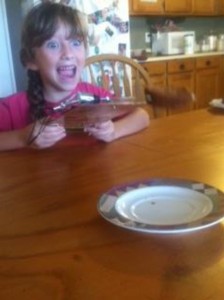 Hello, my name is Genevieve. I am 6. I love science, rockets, and robots and rainbows and all things pink. I am excited to get bigger so I can be a scientist.
Hello, my name is Genevieve. I am 6. I love science, rockets, and robots and rainbows and all things pink. I am excited to get bigger so I can be a scientist.
When my mom showed me the cookie snatcher robot project I got very excited. This would be my 4th robot, but the others were solar powered.
First I connected the motor and nut to the popsicle sticks and made them into 1 group. Then I put the battery cases on and made the switches Then I connected the wires
I have 2 older brothers and I wanted to use their toothbrushes for the grabbers, but mom said no. Darn ! So I used more popsicle sticks instead
The nut on my robot moved so fast my mom and dad had to put a rubber band at the end of the bolt to keep the nut from coming off.
I followed along with the video and only needed a little help from my mom and dad. It was so much fun to do it by myself.
I can’t wait to do more, but first I think I want to add wheels and a cart so I can get as many cookies as I can. I want to make an alligator cookie snatcher too.
Thank you for all of the fun projects!
Supercharged Science helps you create outstanding learning opportunities for your students by focusing on wonder, discovery, and imagination.
I want to thank you for the wonderful half school year that I’ve done in science. I’ve had fun doing the experiments I’m actually almost done all the units! I attached a video of my bristlebot.
[jwplayer config=StandardPlayer file=http://escience.s3.amazonaws.com/main-escience/kid-movie2.flv image=https://www.sciencelearningspace2.com/wp-content/uploads/2010/09/kidmovie2.jpg]
I have a couple pictures I will show you:
This one below is of a magnifying glass and a leaf from Unit 9.
And this is my jigglebot!
Just thought you’d enjoy seeing some of your excited students in Anchorage, Alaska. We learned that it’s best to make colored rockets so we might have a better chance of locating them in the deep snow. Pinks and purples are preferred to yellow since digging up yellow snow can be risky, if you know what I mean.
To give you some perspective, the kids are standing on a picnic table top so they may have a hard surface upon which to stomp the soda bottle. This is a record snowfall so far this winter.
Thanks for the great project. We had a blast!!
[jwplayer config=StandardPlayer file=http://escience.s3.amazonaws.com/main-escience/kid-movie1.flv image=https://www.sciencelearningspace2.com/wp-content/uploads/2010/09/kidmovie1.jpg]
All the best,
Samantha, Mason & Allegria
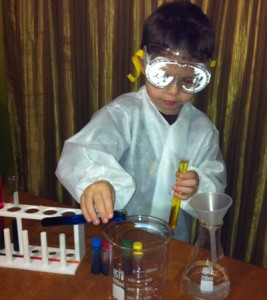 “…Thank you for the free tele-classes. Also my son got “pouring science” (the homesciencetools chemistry set recommended on your site) but I’m just letting him pour colored water back and forth while he learns not to spill.”
“…Thank you for the free tele-classes. Also my son got “pouring science” (the homesciencetools chemistry set recommended on your site) but I’m just letting him pour colored water back and forth while he learns not to spill.”
“…whenever I sing that catchy insurance jingle, “we are farmers”,
He says “we’re not farmers. We’re scientists.”
I have been pre-schooling him at home, but he definitely has had the spark for science lighted.
My husband was happy to see that our boy is handy with a little screw driver thanks to your robotics summer lab.
(He kept asking for this “pouring science” mainly because of the pics on your site.)
Quotes we’ve memorized from your live tele classes:
- What does soda have that water does not have?
Bubbles. - What are bubbles?
Gas. - Which is faster, thunder or lightening?
Lightening. - What is fire?
Heat and light. - What else is fire?
Gas and Plasma.
We’ll keep adding to it. Thanks!
[jwplayer config=StandardPlayer file=http://escience.s3.amazonaws.com/main-escience/sciencejan32012002.flv image=https://www.sciencelearningspace2.com/wp-content/themes/chrome_20/images/tadaa1.jpg]
This is a recording of a recent live teleclass I did with thousands of kids from all over the world. I’ve included it here so you can participate and learn!
Discover the world of clean, renewable energy that scientists are developing today! Explore how they are harnessing the energy of tides and waves, lean how cars can run on just sunlight and water, tour a hydroelectric power plant, visit the largest wind farms on the planet, and more! You’ll learn how streets are being designed to generate electricity, how teenagers are making jet fuel from pond scum in their garage, and how 70 million tons of salt can provide free, clean energy 24 hours a day forever! During class, you’ll learn how to bake solar cookies, magni-fry marshmallows and do the experiment with light Einstein won a Nobel prize for that is the basis of all photovoltaic energy today.
Materials:
- One cup each: hot (not boiling), cold, and room temperature water
- Cardboard box, shoebox size or larger.
- Aluminum foil
- Plastic wrap (like Saran wrap or Cling wrap)
- Hot glue, razor, scissors, tape
- Wooden skewers (BBQ-style)
- Black construction paper
- Cookie dough (your favorite kind!)
- Chocolate, large marshmallows, & graham crackers if you want to make s’mores! If not, try just the large marshmallow.
- Large page magnifier (also called a Fresnel lens, found at drug stores or places that also sell reading glasses, or at Amazon.com)
[am4show have=’p8;p9;p97;’ guest_error=’Guest error message’ user_error=’User error message’ ]
What’s Going On?
For the main experiment:
The Fresnel (“FRAY-nell”) lens is a lot like a magnifying glass. Convex lenses (like a handheld magnifier) are thicker in the middle – you can actually feel it with your fingers. A Fresnel lens was first used in the 1800s to focus the beam in a lighthouse. It has lots of ridges you can feel with your fingers. It’s basically a series of magnifying lenses stacked together in rings (like in a tree trunk) to magnify an image.
The Fresnel lens in this project is focusing the incoming sunlight much more powerfully than a regular hand held magnifier. But focusing the light is only part of the story with your roaster. The other part is how your food cooks as the light hits it. If your food is light-colored, it’s going to cook slower than darker (or charred) food. Notice how the burnt spots on your food heat up more quickly!
The best thing about Fresnel lenses is that they are lightweight, so they can be very large (which is why light houses used these designs). Fresnel lenses curve to keep the focus at the same point, no matter close your light source is.
Questions to Ask
- What other kinds of food can you roast with your setup?
- Does a white marshmallow or chocolate-covered marshmallow cook faster? Why?
- Does it matter what angle you point your roaster at?
- Will it work with an indoor light?
- Why do you need the foil? Can you skip it?
- Do we have to use a Fresnel lens? What about a handheld magnifier – would that work?
[/am4show]
Science Fair Projects. This phrase will strike more fear into the hearts of parents than electrons in a lightning storm. Whether you’re a teacher, parent, kid, or science fair judge, you can quickly turn dread into dexterity with a few quick tips and tricks from the pros of the trade.
Does this sound familiar?[am4show have='p8;p9;p36;p63;' guest_error='Guest error message' user_error='User error message' ]
KID: “I have to do a science fair project.”
PARENT: “Hmmm… what are you going to do?”
KID: (pause) “I dunno.”
PARENT: (eager to help) “What are you interested in?”
KID: (whining now) “I don’t know…”
PARENT: (getting annoyed): “Well, there must be something you’re interested in.”
KID: (still whining) “Like what?”
PARENT: (picking up a science textbook) “Well, how about one from here?”
KID: (rolling eyes): “Yeah, sure. Not.”
The trouble with picking up a textbook and doing a project listed is that they are usually finished projects - meaning that everyone knows not only the experiment but what’s going to happen. No scientist in their right mind would do a experiment if they knew the ending! You’ve got to take a different approach, but before we do, let’s take a quick look at common myths about science projects (namely, your personal expectations about one has to look like).
Your teacher just strode into class and announced that it’s nearly time for the Science Fair, and projects are due next week. You scope out the room and find Brian Brainiac inventing a new addition to the International Space Station… Corey Comet discovering a new species of octopus… and Darlene Dazzler built a transporter. Your head begins to spin like hamster wheel as you try to hit on the Ultimate Science Project that would make Einstein gape with awe.
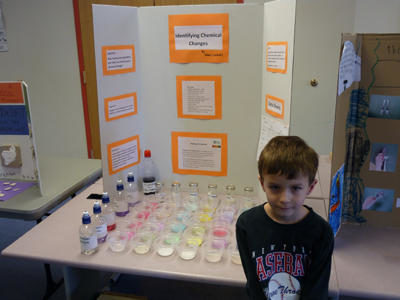
The truth is, science fair projects don’t have to be glitzy, glamorous, or even work quite right… they just have to be yours. And they need to be science experiments, not jazzed-up science reports masquerading as projects.
A science experiment is a simple question you want an answer to, such as:
- “Do later bedtimes really make you sleep better?”
- “Does eating high-sugar foods before bedtime make your dreams more wild?”
- “How many balloons will lift a kid into the air?”
- “What kind of grass needs to be mowed the least?”
A science report answers questions that don’t require any real testing on your part - all you have to do is research to get the answer. Topics like: What is acid rain? What is the sun made of? How does a power plant work? How does the human body work? Is overeating bad for you? We’ve seen reports win local school science fairs, but they don’t make it into the big time regional or national competition. And they aren’t nearly as much fun as doing your own experiment. (They are also NOT appropriate for a real science fair project.)
So, where do you start? Suppose you want to find out if listening to music during a test will help you get a better grade, and if so, which one works the best. You’ll need to first figure out which “thing” (variable) you’re going to change in your experiment to give you different results.
So first, you’ll need to take a test with no music, and record in your notebook the score you got, along with a few other things to help you figure out if it was really the music choice or not. Things like: the weather, your mood, when you woke up, the date, and how difficult the questions were.
A word of caution - don’t change more than one “thing” from one experiment to the next, or you won’t know which change is actually responsible for the new result.
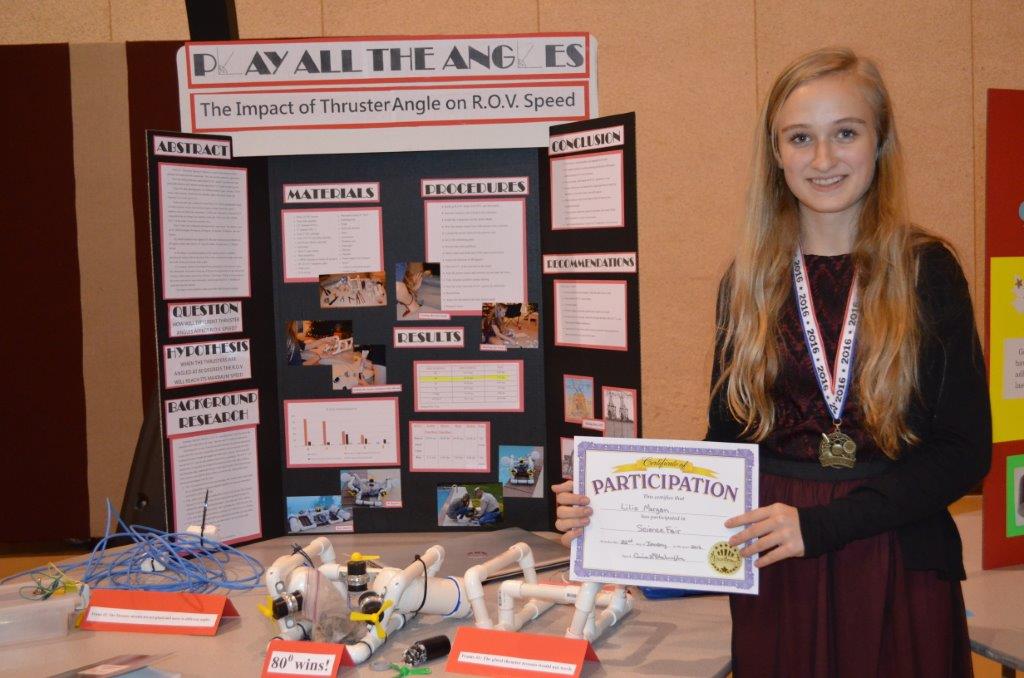 Then you’ll need to test out as many bands as you possibly can, recording not only the stuff above, but also the beat, tone, melody, and how fast or slow the song was… and be sure you’re using the same kind of headphones, too, or that’s another variable you’ve got to keep track of (does sound quality matter?). Are you eating the same breakfast each morning, too? Do you shower each morning, or every other day?
Then you’ll need to test out as many bands as you possibly can, recording not only the stuff above, but also the beat, tone, melody, and how fast or slow the song was… and be sure you’re using the same kind of headphones, too, or that’s another variable you’ve got to keep track of (does sound quality matter?). Are you eating the same breakfast each morning, too? Do you shower each morning, or every other day?
If this is starting to sound like it’s getting a little hard to track all the little differences and changes, well… welcome to science! Scientists spend years trying to sort everything out, track the changes and differences, and make sense of it all. You only have to do it for a week or two. And you can discard any variables you think don’t have a big effect on your results.
Can you imagine what kind of argument you could have at your fingertips if your hypothesis (”Beach Boys Leads to 12% Higher Test Scores”) was successful? Your classroom would never be the same.
How do I cook up a stellar science fair project?
Here is the basic recipe for science fair projects across the globe:
The Scientific Method:
1. Ask a question/Think of an idea
2. Do background research (if possible)
3. Construct hypothesis/Plan your experiment
4. Test with an experiment (This is the fun part, and you can do steps 4 & 5 together)
5. Gather, collect, and record your data and analyze the results
6. Does the hypothesis and results match? If not, go back to step 3.
7. Reach a conclusion
Tips and Tricks for Great Experiments
1. Repeat good results. If you get the result you’re after, then do the experiment again to make sure you can duplicate what happened. And again. And again.
2. Remove yourself. After you’ve listened to music during a test, ask your friends to do the same thing. This checks to make sure that this phenomenon is not just linked to you, but can work for everyone. You are introducing several other variables here (other people), so you can cut down on these pesky variables by asking half the class to take a test with music, and the other half without, and then switch next time. This way, you’ve got music and non-music taking the same test twice. As for number of kids to test it out on, scientists usually aim for sample sizes of over 30, but work with what you’ve got.
3. End with recommendations. This is a personal favorite, not a requirement, but I always like to report on the things I would do if I were to continue experimenting. You can easily make three, four, or even five future experiments that you would consider doing that would further refine your conclusion by drawing on the results you found and the experience you gained.
If you can produce consistent results for not just yourself, but for the whole class, and not only that but plans for future areas of study and relate it back to why this was important enough to study in the first place, now you’ve got an experiment worthy of a blue ribbon.
When things go wrong…
So you’ve taken the steps, come up with questions, formed experiments, and even tested out your ideas, but the results you got make no sense at all. What do you do now?
When I taught at the university, I deliberately gave the students an experiment for which a conclusion did not exist… because the results were never the same twice.
I did this for two reasons… first, to teach them never to cheat and lie about their results (they were given an immediate ‘zero’ without warning if they did “fudge” the results), and second… to teach them how to handle such a thing when it happens for real.
Over half the class got the “F”.
However, they were allowed to “redo” the experiment for a half-grade, if they chose to. Most of them did. Now, why would I do such a thing?
No matter what happens in your experiment, in any experiment, keep in mind that your results stand, no matter what. The laws of the universe, the laws of physics are still working and active… regardless of how you wanted the experiment to turn out. By fudging your results, you can’t really ever be sure if your conclusion stands, and you may as well throw away the entire experiment. But what do you do when you feel like you’ve tried everything, but it still doesn’t work right?
Your greatest moments of thought happen in instances just like this one… One of the most important parts of being a true scientist is being an observer - being able to step back and ask, “What’s really going on here? Why did the marble fly off the track? Was the marble going too slow or fast? Was the track too steep, or too wobbly?”
The truth is, you haven’t tried everything, because if you did, it would be working right now. But it isn’t, so you haven’t. It helps to write down what you have tried… and if you’re keeping good records of your results, this is where you’ll find the information.
You are a great scientist, no matter what results you produce in any experiment. The world will know how sharp you are, how ingenious your mind is when you are able to step back and observe what’s really going on… while the rest of the world gets wrapped up with thoughts that cripple their creativity. “Why didn’t it work? It’s supposed to! It’s broken… it’ll never work. This is dumb.”
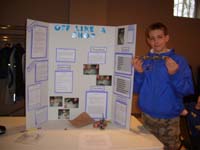 When you get stuck, frustrated (hey, we all do!), or just upset, take a breath, go outside, and remember it’s just one experiment… and you’ll get back to it when you’re ready. Smile, get an ice cream, and remember that there will always more to learn, and no, you’ll never get it all done.
When you get stuck, frustrated (hey, we all do!), or just upset, take a breath, go outside, and remember it’s just one experiment… and you’ll get back to it when you’re ready. Smile, get an ice cream, and remember that there will always more to learn, and no, you’ll never get it all done.
Well, there you have it…
These are the key areas you need to cover for an outstanding science fair project. Remember, you don’t need a Nobel-prize winning project to make headlines at a science fair, nor do you need to sell your car to afford the necessary equipment. Keep it simple, and stick to what you know you can handle so you can do it thoroughly and elegantly.
The photo here is a student taking a prize in his local Science Fair using our linear accelerator project. Did you know that most of the kids that work through our Science Fair Projects take home prizes from the winner's circle? Get started now!
[/am4show]
They also have trouble communicating their ideas in a way that not only makes sense, but also is acceptable by science fairs or other technical competitions designed to get kids thinking like a real scientist. Kids constantly struggle to apply the scientific method to their science project in school, for scout badges, or any other type of report where it’s important that other folks know and understand their work.
In this video, I am going to walk you through all the steps of the scientific method by just doing it so you can really see it in action. I've taken an everyday topic in alternative energy and applied the scientific method to get a real answer to my question about solar cells.
The scientific method is widely used by formal science academia as well as scientific researchers. For most people, it’s a real jump to figure out not only how to do a decent project, but also how to go about formulating a scientific question and investigate answers methodically like a real scientist.
Presenting the results in a meaningful way via “exhibit board”… well, that’s just more of a stretch that most kids just aren’t ready for. There isn’t a whole lot of useful information available on how to do it by the people who really know how.
This section is designed to show you how to do several cool projects (and one really nifty one at the end), walk you through the steps of theorizing, hypothesizing, experimentation, and iterating toward a conclusion the way a real engineer or scientist does. And we’ll also cover communicating your ideas to your audience using a display board and the oral presentation using top tips and tricks from real scientists.
Click to download the reading or start the experiments!
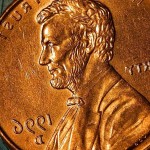 How many drops of water can a penny hold? We’re going to learn how to use the scientific method using everyday materials so you’re comfortable with how it works and how to apply it to every situations. Don’t worry – we’re also going to show you how to do more complicated projects later… but first, let’s cover the basics.
How many drops of water can a penny hold? We’re going to learn how to use the scientific method using everyday materials so you’re comfortable with how it works and how to apply it to every situations. Don’t worry – we’re also going to show you how to do more complicated projects later… but first, let’s cover the basics.
What you need: Pennies, eye or medicine dropper, water, a notebook or science journal.
[am4show have=’p8;p9;p10;p37;’ guest_error=’Guest error message’ user_error=’User error message’ ]
1. Make your observations of the penny; the size, the cleanliness, heads or tails etc. Next look at the water dropper? How big is the opening? How big are the drops that come out, etc?
2. Make your hypothesis. Make a scientific guess as to how many drops you can get on that penny before the water drips off the penny. Unless you’ve done this before, you will almost certainly have a hypothesis that is not very close to your results. Don’t worry about it.
3. Do your test. Slowly but surely put drop after drop on that penny. Eventually you will see a surprisingly large mound of water on the penny that will burst and overflow.
4. Collect your data. Keep a careful count of how many drops are sitting on that penny. For accuracy’s sake, you may want to do this several times (besides, it’s fun) and average your results. (To get an average, add up all your results and then divide by the number of results you got. For example, if you did the experiment three times and got the results 14, 16, and 30 you would add those numbers together (60) and then divide that by 3 (the number of results). So your average would be 20 drops.)
5. Report your results. Once the water spills over the edge, construct an interplanetary telecommunications device to broadcast your results across the universe….or you could just tell your kid brother. It’s up to you. I’ve seen folks get more then 70 drops on a penny! Pretty amazing really. The average seems to be between 30 and 40. The reason the water mounds up like that is because water really likes to stick to itself. It takes a good amount of weight before the water breaks apart.
Would you like to do more with this experiment? What would happen if you used different coins? Is there a mathematical relationship between the number of drops and the size of the coin? Is there a difference between the head side and the tail side of the coin?
The next time you’re about to do something around the house apply the scientific method to it. For example, if you’re about to write something you could apply the scientific method by saying, “I observe that I need a pencil. I hypothesize that there is a pencil in my drawer. I will test this by opening my drawer. I will collect data by looking in the drawer. I will report my data by writing with my pencil or by asking mom where the pencils are.” How could you apply the scientific method to making a peanut butter and jelly sandwich, or walking into a dark room, or buying an ice cream cone? Can you think of others?
Here’s a high-speed slowed-down video on the water drop.
[/am4show]
 Now let’s use the scientific method to discover a couple of things about pendulums. Before we start, I need to tell you two new terms. One is constant variable and the other is changing variable. A variable is a part of your experiment, like the coin in the Underwater Presidents experiment. If it is a constant variable, it stays the same for every trial of that experiment.
Now let’s use the scientific method to discover a couple of things about pendulums. Before we start, I need to tell you two new terms. One is constant variable and the other is changing variable. A variable is a part of your experiment, like the coin in the Underwater Presidents experiment. If it is a constant variable, it stays the same for every trial of that experiment.
For example, we always used the same penny in the Underwater Presidents. Those variables never changed. A changing variable is what you change for each trial. It is often what you are testing for; “If I change this, what happens to that?”
For example, in the Underwater Presidents experiment, if we tried water in the dropper, then we tried vegetable oil, then corn syrup; the changing variable would be the liquid we are using in the droppers. When you do an experiment you have to try very hard to keep all variables constant except for the one you are testing for. If you don’t keep all but one variable constant, you won’t know why you are getting the results you’re getting. If you change the size of the coin, and the type of liquid with the Underwater Presidents experiment, you will have a hard time knowing if it’s the change of coin or the type of liquid that’s causing more or fewer drops on the coin. Let’s try the following experiment and see if this becomes clearer.
What you need:
- String
- Weight of some sort
- Tape
- Timer (or a watch with a second hand)
[am4show have=’p8;p9;p10;p37;’ guest_error=’Guest error message’ user_error=’User error message’ ]
First of all, you have to make your pendulum. A pendulum is really nothing more than a weight at the end of something that can swing back and forth. The easiest way to make one is to get a string and tape it to the edge of a table. The string should be long enough so that it swings fairly close to the ground. Tie a weight of some sort (a washer, a watch, your dog (just kidding, live things make poor pendulums)) to the bottom of your string and you’ve got a pendulum. Now, for this experiment the changing variable is going to be the length of string. In each trial you will be changing the length of the string. The rest of the variables will be constant. The weight at the end of the string, the string itself, the time you will be letting it swing will be the same for every trial. Getting the hang of constant and changing variables now? Okay so here’s what you want to do:
1. Make an observation. Play with the pendulum a bit and see how it behaves.
2. Make a hypothesis. How will the length of string effect the number of swings in 10 seconds? Will there be more, less, or no change in the number of swings as the string gets shorter.
3. Set a timer for 10 seconds or get someone who has a watch with a second hand to tell you when 10 seconds are up.
4. Now for the test. Pull the pendulum back as far as you’d like (the pendulum swings smoother if you don’t lift the weight higher than the top of the string).
5. Start the timer and let go of the weight at the same time.
6. Count the swings the pendulum makes in 10 seconds.
7. Write down what you found (collect the data). This works well if you make a chart with two columns, one for length of the string, and one for number of swings.
8. Do two more trials with the string at that same length.
9. Now change the changing variable. In other words, shorten the string. I would recommend shortening it at least an inch.
10. Redo steps 3 through 9.
11. Continue shortening the string and doing trials until you get at least five trials with five different lengths of string.
12. Now report your results. Take a look at your data and see if you find a trend. Do you get more swings as the string shortens, less swings, or does the length of the string matter? Something interesting to notice is that at a certain length you will get 10 swings in 10 seconds or a swing a second. This is why pendulums are used in grandfather clocks. They keep good time!
[/am4show]
 A constant variable is one that does not change from trial to trial. A changing variable is the one variable you are testing for. It does change from trial to trial. One of the most difficult things to do in scientific research is to know what all of your variables are and to keep all but one variable constant.
A constant variable is one that does not change from trial to trial. A changing variable is the one variable you are testing for. It does change from trial to trial. One of the most difficult things to do in scientific research is to know what all of your variables are and to keep all but one variable constant.
In these pendulum experiments other variables were the temperature of the room, the humidity, the spin of the Earth, the design of the pendulum, etc., etc. We made an assumption that all those variables remained constant and didn’t really matter to our experiments. In this case, that’s a safe assumption but sometimes you can’t be too sure!
Constant and changing variables are around you all the time. What would be some variables in your breakfast? Which ones change from morning to morning? Which ones stay the same? What about some variables in the car? Which are constant and which are changing?
Let’s take a look at how to handle these questions:
What you need:
- String
- Several weights of some sort (a bunch of the same kind of washer works very well)
- Tape
- Scale (optional)
- Timer (or a watch with a second hand)
- Use the same pendulum set up you used for “The Size of the Swing” experiment.
[am4show have=’p8;p9;p10;p37;’ guest_error=’Guest error message’ user_error=’User error message’ ]
1. Make an observation. Play with the pendulum a bit and see how it behaves.
2. Make a hypothesis. How will the weight of the bob (the weight at the end of the pendulum) effect the number of swings in 10 seconds? Will there be more, less, or no change in the number of swings as the bob gets heavier.
3. Set a timer for 10 seconds or get someone who has a watch with a second hand to tell you when 10 seconds are up.
4. Now for the test. Pull the pendulum back as far as you’d like.
5. Start the timer and let go of the weight at the same time.
6. Count the swings the pendulum makes in 10 seconds.
7. Write down what you found (collect the data). This works well if you make a chart with two columns, one for weight of the bob, and one for number of swings.
8. Do two more trials with the same bob.
9. Now change the changing variable. In this case you want to increase the weight of the bob. If you have several washers of the same kind, the easiest way to do this is to just add more washers to the end of the string. You can also add paperclips if you have quite a few of them. If you don’t, then change the bob to different objects that get heavier and heavier with each trial. If you change the number of objects, just record how many you have (3 washers, 10 paper clips, etc.). If you change the type of object and have a scale, record the weights of the objects. If you don’t have a scale, just put the objects in order of increasing weight. The actual mass of the objects doesn’t really matter as you’ll see by your conclusions. Remember to change the weight of the bob, but don’t change the length of string. The weight of the bob is your changing variable this time. The length of string is… what variable? Constant. Right, you’re getting the hang of this!
10. Redo steps 3 through 9.
11. Continue increasing the weight and doing trials until you get at least five trials with five different weights.
12. Now report your results. Take a look at your data and see if you find a trend. Do you get more swings as the weight increases, less swings, or does the weight of the bob matter? Are you surprise by the fact that weight didn’t matter? Next lesson we will discuss gravity and then this odd result will make sense.
Feel free to continue playing with the pendulum. You dropped the bob from about the same height each time. Would you get different results if you dropped the bob from different heights? Try it, but remember to keep the string and the weight constant. If you do this experiment, what is your changing variable? The height of the drop, right? See you are paying attention!!
[/am4show]
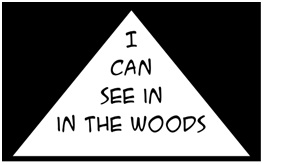 The first step of the scientific method is observation. In my opinion, this is the most important and enjoyable part of the scientific method. Observation is the skill of “seeing” things that are there, “seeing” things that aren’t there and “seeing” things that should be there.
The first step of the scientific method is observation. In my opinion, this is the most important and enjoyable part of the scientific method. Observation is the skill of “seeing” things that are there, “seeing” things that aren’t there and “seeing” things that should be there.
Observation is the skill that separates scientists from super scientists. Einstein, Galileo and Newton, for example, were fantastic observers. They were able to “see” beyond and through what other people were able to “see” before them in order to get to deeper truths inside science.
I’m putting “see” in quotes because there’s more to observing then just seeing with your eyes. First, you need to detect something. You can use your eyes, ears and nose to detect things. You can also use instruments like telescopes, microscopes or prisms to detect things. Somehow, something needs to come to your attention.
But that’s not all there is to observing something. Next you need to use your knowledge and your intuition, to fully observe what’s happening. When you look up into the night sky you might only see bunches of little white dots, but a trained astronomer would see stars of different magnitudes, galaxies and constellations. The astronomer’s knowledge allows her to “see” more. This is why I think observation is so much fun.
Observing allows you to know things and knowing things allows you to observe more things! You can’t help but get smarter if you spend your time observing! In this lesson, we’re going to spend time becoming better observers. Try this activity.
[am4show have=’p8;p9;p10;p37;’ guest_error=’Guest error message’ user_error=’User error message’ ]
You need:
- A partner
1. Tell your partner that you are going to give them about 5 seconds to read a sentence.
2. Let your partner take a look at the sentence and count to 5 slowly in your head and then take the sentence away.
3. Ask your partner what the sentence says in the image above.
4. If they are wrong, which they almost always are, give the sentence back to your partner and let him or her look at it again.
5. Marvel at how long it takes your partner to find out what the sentence really says!
This activity never fails to amaze me. This is a great example of the difference between seeing and perceiving. Your eyes see, your mind perceives and unfortunately, it’s not uncommon for something to get messed up along the way! Your eyes saw that second “in” but your mind edited it! In fact, you had to focus quite hard before your mind allowed you to “see” what was really there! Strange, but true.
[/am4show]
We’re going to build on the idea from the last experiment by adding a color component to the experiment. Here’s what you need to do:
You need:
- Paper
- Pencils
- Volunteers
[am4show have=’p8;p9;p10;p37;’ guest_error=’Guest error message’ user_error=’User error message’ ]
1. Tell your volunteers that you are going to give them 30 seconds to look at a picture and try to remember as many things as they can about the picture.
2. Let them see the picture and count to 30 in your head.
3. Now hand each of them a piece of paper and a pencil or pen.
4. Tell them to draw as much of the picture as they can, in as much detail as possible. Tell them not to worry about being artistic but just try to include as much about the picture as possible in their drawing.
5. Tell them to write the color of the objects on their drawing as well.
6. Let them take about 2-5 minutes to create their drawing.
7. When folks are done, show them the picture again so that they can compare their drawings with the picture.
Did your artist draw everything? Did something get forgotten? Did something get added? Was there something that was the wrong color? Now ask your artist how sure they were that something in their drawing was actually in the picture.
I always enjoy watching the faces of the students when I show them the picture the second time. They always get surprised when something is in the picture that was not in their drawing, or even more fun, when something was in their drawing that was not in the picture!
Chances are they were pretty confident that there was a cloud in the picture, or that the dog was yellow or whatever it may have been. Your eyes see what is there, all the colors and shapes. Your mind, however, has to interpret what your eyes see and pretty often it will forget things or completely change them around! Again, your eyes see but your mind perceives!
[/am4show]
This is an excellent exercise in observation. I highly recommend finding other pictures in books and magazines and doing this several times. It’s a great way to get better and better at the skill of observation. It’s also a nice way to pass the time in a waiting room!
You need:
- The question sheet below
- Paper
- Pencils
- Friends
[am4show have=’p8;p9;p10;p37;’ guest_error=’Guest error message’ user_error=’User error message’ ]
1. Tell your friends you’re going to show them a picture for 30 seconds. You want them to try to observe the picture carefully and remember as much about it as possible.
2. Now show them the picture and count to 30 in your head.
3. Take the picture away and hand them a piece of paper.
4. Have them number the paper from 1 to 10.
5. Tell them to try to answer each question as best as they can. Make a guess if necessary. If they can’t remember the answer at all, they can leave that question blank.
6. Also, tell them to put a check mark next to any answer they are certain is correct.
7. Read them the questions.
8. When your friends have answered all the questions, let them see the picture and check their answers.
9. Take a look at the answers they were certain they had the right answer. Did they?
Questions for the Fishy Scene
1. How many small fish are in the sea weeds?
2. Is the worm on the right or the left hook?
3. How many leaves does the sea weed on the rock have?
4. Is the snail pointing left or right?
5. Is the fellow in the blue shirt smiling or frowning? Can you guess why?
6. What color spots does the spotted fish have?
7. How many fish have stripes?
8. What color hair do the fishermen have?
9. What color is the fish that doesn’t have a dorsal fin (the fin on the back)?
10. How many plants are in the picture?
Answers:
1. 5 small fish.
2. On the right hook.
3. 3 leaves.
4. The snail is pointing left.
5. He’s frowning. Probably because he’s not getting any bites since he has no bait.
6. Green spots.
7. One fish has stripes.
8. Blond and Black
9. Yellow
10. 3 plants.
[/am4show]
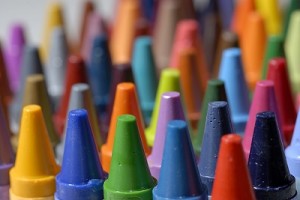 Observation is a skill just like any other skill and it can be exercised and improved over time. Being a good observer means always keeping your eyes open and being aware of what’s around you. With good observation skills and knowledge the world becomes just that much more wonder-filled!
Observation is a skill just like any other skill and it can be exercised and improved over time. Being a good observer means always keeping your eyes open and being aware of what’s around you. With good observation skills and knowledge the world becomes just that much more wonder-filled!
Here’s an activity you can do to hone your observation skills:
You need:
- 5 to 10 small items (pencils, crayons, balls, eraser, toy cars, buttons, whatever is handy)
- A handkerchief or napkin large enough to cover all the items.
- Some friends
[am4show have=’p8;p9;p10;p37;’ guest_error=’Guest error message’ user_error=’User error message’ ]
1. Lay out all the small items on a table.
2. Cover the items with the napkin.
3. Tell your friends you’re going to give them 10 seconds to look at and memorize the items and where they are.
4. Take the napkin off for 10 seconds and let your friends look. Cover it back up when time is up.
5. Now move, take away, or add something to the pile of things without letting your friends see what you’re doing.
6. Invite your friends to try to guess what it was you moved, removed, or added.
7. Do it again and take turns being the mover.
This is another great exercise to improve your observation skills. I do this with my family at restaurants. I just grab stuff on the table, lay it out and have my family try to guess what’s been changed. (Be careful of grumpy waitresses!)
[/am4show]
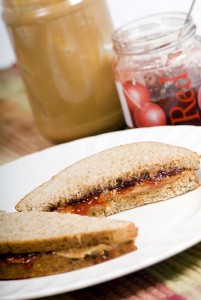 Fish in the can saws wild apples dog car sidewalk tree. Shirt the table carpet in the floor roof cloud. What? What do you mean I’m not making sense? I’m using simple English words. Oh, I see. I must not be communicating.
Fish in the can saws wild apples dog car sidewalk tree. Shirt the table carpet in the floor roof cloud. What? What do you mean I’m not making sense? I’m using simple English words. Oh, I see. I must not be communicating.
Believe it or not, communication is not as easy as it seems. In this lesson, I’m hoping to show you that hearing what someone is saying, and saying what you want someone to hear is quite a skill. A good skill for life and a vital skill for science.
In science, the ability to tell someone what you did, how you did it, and what happened after you did it, is a key skill in sharing science information. Scientists from around the world share information and their measurements and details of what they did must be very precise. To begin with, let’s try this little exercise in giving directions.
You need:
- Peanut Butter
- Jelly
- Bread
- Butter Knife
(Be prepared to make a mess and have fun.)
[am4show have=’p8;p9;p10;p37;’ guest_error=’Guest error message’ user_error=’User error message’ ]
1. Pick a person to be the sandwich maker (this works better if it’s someone who’s kind of in on the game).
2. The sandwich maker tells the group that he or she is a robot who does everything that it is told. However, the robot is very literal, so it does EXACTLY what it is told to do.
3. The rest of the group gives one instruction at a time (“Put the jam on the bread.”) until the sandwich is made or until no one can stand laughing anymore.
The key to this activity is the sandwich maker. The robot must do exactly what he or she is told. So when the robot is told to put the jam on the bread, the robot takes the jar of jam and puts it on the bag that the loaf of bread is in! When the robot is told to take the bread out of the bag, the robot can’t do it because the bread bag isn’t open! Have a lot of fun with this, it’s messy and makes a great point.
It’s a little harder to tell someone how to make a sandwich than you thought right?! Try telling a robot how to tie its shoes. Or for that matter, walk across the room. It’s quite hard. Communication involves a lot of assumptions.
An assumption is when you expect someone to know what you’re talking about. You assumed that when you told your “robot” to put the jam on the bread, that the robot would know that it needed to open the jar. Then you might have told the robot to open the jar and it didn’t know how to do that either! Again, you assumed something that is obvious to you but not at all obvious, perhaps, to something or somebody else.
My father tells the story of when he learned this lesson the hard way. When he was a kid there was a hole under the porch at his house. His Mom noticed a board sitting on the ground and told my Dad to fill the hole with the wood. Well, my father, being a good little boy, did exactly as he was told and put the wood as far into the hole as he could, leaving a good two feet of board sticking out of the hole. His mother came back from what she was doing, took one look at the wood sticking out of the hole and proceeded to yell at my father for being such a dummy. My father was clueless. As far as he could tell, he did exactly what he was asked to do. However, his mother assumed that when she said fill the hole with the wood, he would use the wood to push dirt into the hole. My father followed the directions correctly but was wrong. His mom gave directions correctly and was also wrong.
As you can see, communication can be very difficult. I’m willing to bet this kind of thing has happened to you. You have told someone to do something and they messed it up or someone told you to do something and you messed it up. Keep this in mind the next time something gets messed up. A little better communication can keep a lot of things from getting messed up (and keep you out of trouble as well).
[/am4show]
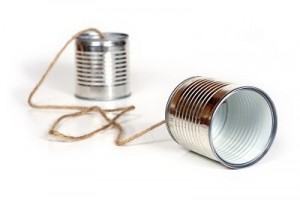 Communication isn’t just giving directions however. It’s also hearing what’s being said and following directions. How good are you at following directions? (I know the first time I tried this experiment, I didn’t do nearly so well!)
Communication isn’t just giving directions however. It’s also hearing what’s being said and following directions. How good are you at following directions? (I know the first time I tried this experiment, I didn’t do nearly so well!)
Try this:
You Need: The instruction sheet (see below), one for each person in the group, and pencils for each person in the group.
[am4show have=’p8;p9;p10;p37;’ guest_error=’Guest error message’ user_error=’User error message’ ]
1. Pass the instruction sheet to everyone in your group. Click here to download the Get The Picture instruction sheet .
2. Tell everyone to read the instructions carefully and to go ahead and get started.
3. The answers for “Get The Picture” are at the end of the lesson (below).
Get The Picture Instruction Sheet
Please follow the following directions exactly. Do everything that the instructions say. Read all the following directions before beginning.
1. Circle the word circle in this sentence.
2. Write the third word in this sentence here. __________________
3. Draw a large square on the back of this paper.
4. Draw a large triangle on top of the square on the back of this paper.
5. Draw a rectangle inside the square with a short side touching the middle of the bottom of the square on the back of this paper.
6. Draw a small square to the right of the rectangle in the large square on the back of this paper.
7. Draw a circle above the left side of the triangle.
8. Ignore every single instruction on this page but this one. Turn your paper over and draw a big smiley face on the paper. There should be nothing on the back of this page but one big smiley face. After you’ve drawn your smiley face turn this page back over.
Answer to Get the Picture: There should be nothing on the page except for a smiley face on the back! So now you’ve had a chance to see that giving directions is difficult and following directions is difficult. Let’s put it all together with this next activity.
[/am4show]
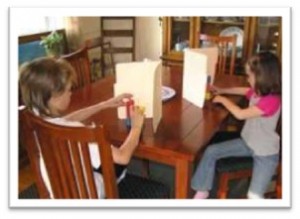 This is a great activity and it really shows how hard it is to communicate with someone. It does a great job at pointing out assumptions and showing how careful and detailed you have to be with your instructions. It also shows that the listener has an important role to play. The listener must be very careful not to make assumptions and to be sure to take responsibility for what they are hearing by asking good questions.
This is a great activity and it really shows how hard it is to communicate with someone. It does a great job at pointing out assumptions and showing how careful and detailed you have to be with your instructions. It also shows that the listener has an important role to play. The listener must be very careful not to make assumptions and to be sure to take responsibility for what they are hearing by asking good questions.
One more thing this activity does is show how important definitions are to good communication. When I do this activity with my groups, I do it a few times and then take the time to point out some of the definitions the group has been using. For example, when they call one block the red square everyone knows which block that is. I also point out where a definition can come in handy.
For example “Stand the blue block on its side.” Well, which side? Long side, short side, fat side… how do you know? At this point, I take the time with the group to create definitions. “Okay, so when we say long side that always means this side of this block.” As you do this activity, you’ll see where assumptions are made and definitions can come in handy. In science, good definitions are vital. If somebody says, “I put the apparatus one meter from the ping pong ball.” Everyone in the world knows how far a meter is. There is a standard for meters, inches, cups, liters, ohms, joules and all sorts of measurements. Without good definitions no one would know what anyone was talking about!
[am4show have=’p8;p9;p10;p37;’ guest_error=’Guest error message’ user_error=’User error message’ ]
You need:
- Identical sets of five different objects for each person in your group. For example, each person in the group has the same set of five different blocks, or everyone in your group has their own fork, apple, napkin, pencil and toy car. It doesn’t matter what the items are but for the instructions below I’m going to use blocks as my items.
- Some sort of screen to allow everyone to keep their items hidden from prying eyes. I use file folders. Open them up about 90 degrees, they stand up nice and the kids can keep their stuff hidden behind them.
1. Pick one person to be the “teller”. Everybody else will be “listeners”.
2. The teller will put his or her blocks together any way he wants. Make sure no one can see how the blocks are laid out. The teller can stack them on top of one another, lay them end to end or do whatever he feels like. I highly recommend only using three blocks the first two or three times.
3. Now, the teller has to carefully tell the listeners what he or she has constructed. The teller’s job is to get all the listeners to build exactly what she has built. The teller should only use her voice to explain how the blocks look. She shouldn’t hold any blocks up or use her hands to show how the blocks are laid out.
4. As the teller describes what has been built, the listeners should try the best they can to build what’s being described.
5. Once the teller feels he or she has explained everything, he should uncover his blocks and let everyone see what he was trying to describe. Take a look at everyone’s blocks. How well do they match?
6. Let everyone have a turn being the teller.
7. For the first couple of times don’t let anyone ask any questions. It is completely the job of the teller to make sure everyone can make the same block constructions.
8. After a few tries, let the listeners ask the teller questions. Emphasize that now the listeners have a responsibility to make sure they get it right. It’s no longer only up to the teller. If they have their blocks set up wrong now, they might not have asked a question when they should have.
Well, I hope I was able to communicate how important and how difficult it is to have good communication. Whenever you write something, read something, say something or hear something, be very careful to make sure you’re not assuming something. Try to make sure your listener truly hears what you’re saying, and vice versa, try to make sure you’re hearing what someone’s telling you.
[/am4show]
Ready for MORE?
You’ll find several ultra-cool projects under the ‘Advanced‘ section that walk you step by step through not only the experiment but also the scientific method.
Rocketry
Fruit Batteries
Linear Accelerator
Measuring the Speed of Light
Alternative Energy
Hovercraft
Underwater ROV Robot
Crystal Radio
I’ve shown you how to take an ordinary experiment and transform it into something you can turn into a science fair… but you don’t need to enter a competition to work through these projects at all. Simply watch the videos and learn how to apply the scientific method to any experiment.
Download the Unit 15: Advanced Chemistry file here.
Don’t forget – we didn’t record this track in a professional studio, so don’t worry if you hear pops, clicks, chimes, or other odd sounds – just focus on the real message and the learning that’s going on. Are you ready??
Download the Unit 14: Electronics file here.
Don’t forget – we didn’t record this track in a professional studio, so don’t worry if you hear pops, clicks, chimes, or other odd sounds – just focus on the real message and the learning that’s going on. Are you ready??
Wired Remote Control Car
We used a plastic throat lozenge box container to make our remote control. And to make the car look cooler, we used a mushroom box for a top. We tried a Kleenex box but that was too heavy and it wouldn’t allow it to turn as well. We also used telephone wire to make it easier to wire to both motors.
What we learned:
Wires can get put on the wrong way but it is easy to switch back around so the car moves in the right direction. Having switches to turn something on and off is much better than needing to disconnect wires. Wide rubber bands on the wheels add more traction.
This project took a lot of patience to get it to work the way we wanted it to.
Materials used:
large size popcicle sticks, vinyl tubing, syringes, water, hot glue, brass fasteners, wire, plastic cup, wheels, skewers and straws
How it works:
The syringes and tubing are filled with water and when one set pushes in, the other pushes out causing the vehicle to move its arm up or down. We color coded ours so we would know which syringe moved what part of the vehicle.
This is how some construction trucks work except they use oil instead of water. This was a complicated project but really cool when it’s done. All our friends are impressed with this and love to try it out!
Download Student Worksheet & Exercises
Click on image above to enlarge.
Exercises
- Hydraulics refers to the use of what to do work?
- Solids
- Gases
- Fluids
- Liquids
- What is it called when we use air to do work?
- Aerodynes
- Pneumatics
- Nitrous
- Oxygenation
- In general, liquids cannot be squished together. What do we call this?
- Impressive
- Immersive
- Inert
- Incompressible
- Is the answer to the previous question important to how all hydraulic systems work?
- Yes
- No
 We love kites and have lots of them. Sled kites are the easiest to fly and easy to make. Tetrahedral kits are more of a challenge but worth the extra work. My mom had to help with a lot of the knot tying.
We love kites and have lots of them. Sled kites are the easiest to fly and easy to make. Tetrahedral kits are more of a challenge but worth the extra work. My mom had to help with a lot of the knot tying.
What we learned:
Kites are like planes. The forces on them are the same. They are the lift, thrust, drag and the weight.
When we made a larger version of the tetrahedral kite we discovered that it flew better without a bridle. We attached the lead string directly to the kite and it doesn’t need a tail for stability either. When we made a smaller one, it needed the bridle and tail to keep it from spinning around. The best size we made was using 9 and a half inch straws. This made a bigger surface area for the tissue paper skin. When we first tried to fly this we were actually attempting to fly it upside down. We thought the wind should catch it more like a parachute to fly it. But then we realized it was more like an airplane flying like a v-shape in the air. That worked much better.
Once we made the 10 cell kite and tried it out we figured it would fly even better if it had more surface area so we made another level and changed it to a 20 cell kite. It worked and flew great! Someday we may even add more but we’ll have to do that work out in the garage because it won’t fit through our door!
Click on an image to enlarge:
 |
 |
|
 |
 |
|
Copper tubing, votive and birthday candles, a lighter and matches, foam insulation and foil bread and pie pans
How Elijah built his boat:
First my dad coiled the copper tubing for us. Then I got a piece of foam and then I drilled holes for my tubing and dug another hole for my candle to sit in which I covered in foil to protect the foam from burning or melting. Then I used a pie pan and bent it to fit and cut a hole in the top for a smoke vent and to let oxygen in. I used a birthday candle so I could get a bigger flame. It worked great and moved very fast in the water. I named it the Turbo Turtle.
How Hannah built her boat:
My boat was more boat shaped. I used a tin bread pan and bent the back of the pan inward to set my copper tubing on. I hot glued it in place. Then I used metal tape to set the candle on so sit wouldn’t slip. For decoration I used cut pieces of a pie pan to make a top section and a flag for the back.
How Eliana built her boat:
My mom helped me drill holes in the back on the bread pan and we put the coil through those and used lots of hot glue to try to seal it. We used a little piece of foam to hold it up. Then we put the candle in the middle. Mine worked for a little while but then got leaks so I just decorated mine the way I wanted and used it to play with.
What we learned and how it worked:
We filled the copper tubing with water and put it in the pool and lit the candle and waited a short while and then watched it shake and then start cruising. The water in the tubing boils causing steam that pushes out the back and then causes a vacuum to suck more water back in and start the cycle over again. These worked really good and it was fun to be creative with it.
Click on an image to enlarge:
 |
 |
|
 |
 |
|
We got together with a group of friends and made four different kind of solar ovens.
The first one was large (2’x3′). My mom helped with this one. We used a box inside another box and we insulated it with foam insulation on the bottom and newspapers on the side. We were hoping this would allow the temperature to get about 300 degrees. We lined the inside of the box with foil to keep the heat in and lined that with black paper to absorb the heat. We used foam board covered in a paper mirror sheeting for reflectors. We attached those on 3 sides. Inside we used a rack to raise the food off the bottom of the oven and to be able to get the best angle of the sun. We also needed to tip the whole box to make sure we didn’t have shadows inside the oven. Then we covered the top with sheets of glass to help insulate more.
The second ovens were made out of pizza boxes. After we cut our windows, we used slow cooker oven liners for the windows instead of plastic wrap so we would not have a chemical reaction with the heated plastic. We also insulated these with a thin layer of foam on the bottom before the foil and black paper.
The third ovens we made were hot dog cookers made out of pringle’s chips cans. We cut a slit down the middle and made flaps to open and then used the cooker liners for windows again. Last we drilled holes in each end for a skewer to fit through.
The fourth oven was a funnel shaped cooker. We covered poster board with foil and shaped that into a funnel and used a foil covered piece of foam for the base. Then we covered a jar with black paper to use for cooking.
Into the (preheated) big oven we put chocolate chip cookie dough. And to compared ovens we put cookie dough in one of the pizza box ovens as well. The cookies in the big oven were done in about 20 minutes. The oven had reached about 250 degrees. The smaller oven took about 40 minutes and had reached 200 degrees.
In the rest of the pizza box ovens we had chips and cheese for nachos and one box had an egg cooking. We all used dark colored pans inside the cookers. The cheese only took about 10-15 minutes to melt. The egg took about an hour.
In the pringles cans we cooked hot dogs which took 1/2 an hour to reach 170 degrees. We were hungry and couldn’t wait longer than that.
The jar inside the funnel cooker had green beans from our garden in it. They never really got done. The temp only reached 160 degrees but this was probably because it was really cold to start with so it was taking to long to heat. And then it got cloudy. Oh well, no veggies that day!
This was super fun to do. We had a lot of success. We were surprised how quickly the cookies got done even though it didn’t get as hot as we were hoping it would.
Click on an image to enlarge.
 |
 |
|
 |
 |
|
I had a lot of fun making this. Thank you, Aurora, for showing me how to do all this.
This really was a challenge to connect up! But now I know how to make a Motor Reversal Switch…Nightmare!
I didn’t have a wooden peg to push the tacks through, so I have used a plastic peg with metal clips wrapped around the peg opening. Also, I couldn’t find fishing line to use for the trip wire, so I had to use some other line, but it still works well.
[am4show have=’p8;p9;p20;p47;p108;p76;’ guest_error=’Guest error message’ user_error=’User error message’ ]
[/am4show]
We did this with a group of friends so we started with 18 cups of sugar but ended up using a whole 25 pound bag to get the solution supersaturated.
We used superfine sugar which dissolved really quickly so it was hard to tell when there were bits still on the bottom. We also flavored it with some LifeSaver candies.
We used 4 different jars to grow our crystals. In one we had a string suspended in it with no lid. In the second, we used a skewer with a lid on. In the third, we had a skewer with the lid partway off. And in the fourth, we had a skewer and the lid was mostly off. The only major difference we noticed was with the jar with the string and no cover at all. the crystals are not lined up as neatly and it’s kind of big and chunky. The skewers helped to form the crystals more uniformly. We also don’t think evaporation was too important in the forming of the crystals.
We learned that sugar crystals are shaped like prisms and rectangles and that the growth is not just a multiplication of more crystals, the crystals themselves actually get bigger. Most of our growth happened within the first 3 weeks. They haven’t changed much since then. So we concluded that this had something to do with the superfine sugar versus regular sugar. Next time we’ll have to try it with regular to compare the growth rate.
This was fun to do and hopefully our mom will actually let us eat it now!
Click on an image to enlarge.
Download the Unit 13: Thermodynamics file here.
Don’t forget – we didn’t record this track in a professional studio, so don’t worry if you hear pops, clicks, chimes, or other odd sounds – just focus on the real message and the learning that’s going on. Are you ready??
Earn $$ telling people about eScience! Click to learn how to become a Supercharged Science Affiliate…
Download the Unit 12: Alternative Energy file here.
Don’t forget – we didn’t record this track in a professional studio, so don’t worry if you hear pops, clicks, chimes, or other odd sounds – just focus on the real message and the learning that’s going on. Are you ready??
Download the Unit 11: Magnetism file here.
Don’t forget – we didn’t record this track in a professional studio, so don’t worry if you hear pops, clicks, chimes, or other odd sounds – just focus on the real message and the learning that’s going on. Are you ready??
Download the Unit 9: Light & Lasers file here.
Don’t forget – we didn’t record this track in a professional studio, so don’t worry if you hear pops, clicks, chimes, or other odd sounds – just focus on the real message and the learning that’s going on. Are you ready??
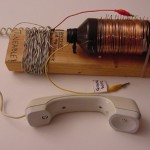 This article has all the information you need to complete a Science Fair Project, including instructional step-by-step video, documentation, required forms, experimentation tips and tricks, and how to squeeze your great idea into the scientific method.
This article has all the information you need to complete a Science Fair Project, including instructional step-by-step video, documentation, required forms, experimentation tips and tricks, and how to squeeze your great idea into the scientific method.This experiment is for advanced students.
[am4show have='p9;p63;' guest_error='Guest error message' user_error='User error message' ] Step 1: Download the Project Guide.
Step 2: Watch the video here...... but note that this video is LOOOOOONG - nearly 2 hours! We just didn't want to forget anything, and we also wanted to give you all the best information we have, so enjoy! (And you'll find that the video intro is the same as the last project's.) If you just want the Crystal Radio video itself without all the Science Fair stuff, click here for project-only video.
Step 3: Download the parts list and data sheet. (You'll need the free Adobe Reader view the PDF files.)
Need parts?
- Toilet paper tube
- Magnet wire
- Germanium diode: 1N34A
- 4.7k-ohm resistor
- Alligator clip test leads
- 100’ stranded insulated wire (for the antenna)
- Scrap of cardboard
- Brass fasteners (3-4)
- Telephone handset or get a crystal earphone
Step 5: Log your data and chart your graphs. Download a copy of Excel from Microsoft. Once you have Excel running, use it to chart your data. Click here for sample Excel file.
Step 6: Write your report. You'll find a sample report in the Project Guide.
Step 7 : Build your display board and exhibit. Find tips & tricks in both the video and the Project Guide. Click here to view the sample display board format.
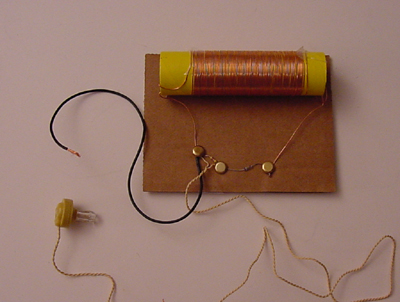
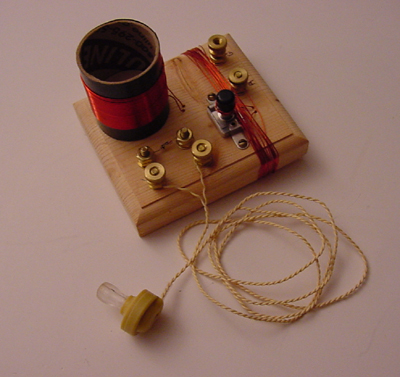 [/am4show]
[/am4show]Download the Unit 8: Chemistry file here.
Don’t forget – we didn’t record this track in a professional studio, so don’t worry if you hear pops, clicks, chimes, or other odd sounds – just focus on the real message and the learning that’s going on. Are you ready??
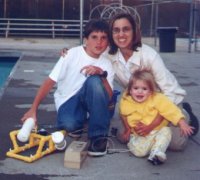 This article has all the information you need to complete a Science Fair Project, including instructional step-by-step video, documentation, required forms, experimentation tips and tricks, and how to squeeze your great idea into the scientific method. This experiment is for advanced students.
This article has all the information you need to complete a Science Fair Project, including instructional step-by-step video, documentation, required forms, experimentation tips and tricks, and how to squeeze your great idea into the scientific method. This experiment is for advanced students.[am4show have='p9;p63;' guest_error='Guest error message' user_error='User error message' ] Step 1: Download the Project Guide.
Step 2: Watch the video here...... but note that this video is LOOOOOONG - nearly 2 hours! We just didn't want to forget anything, and we also wanted to give you all the best information we have, so enjoy! (And you'll find that the video intro is the same as the last project's.) If you just want the R.O.V. video itself without all the Science Fair stuff, click here for project-only video.
Step 3: Download the parts list and data sheet 1 and/or data sheet 2. (You'll need the free Adobe Reader view the PDF files.)
Step 4: Set up and do your experiment.
Step 5: Log your data and chart your graphs. Download a copy of Excel from Microsoft. Once you have Excel running, use it to chart your data. Click here for sample Excel file.
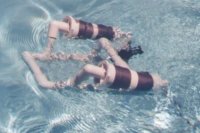 Step 6: Write your report. You'll find a sample report in the Project Guide.
Step 6: Write your report. You'll find a sample report in the Project Guide.Step 7: Build your display board and exhibit. Find tips & tricks in both the video and the Project Guide. Click here to view the sample display board format. [/am4show]
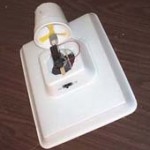 This article has all the information you need to complete a Science Fair Project, including instructional step-by-step video, documentation, required forms, experimentation tips and tricks, and how to squeeze your great idea into the scientific method.
This article has all the information you need to complete a Science Fair Project, including instructional step-by-step video, documentation, required forms, experimentation tips and tricks, and how to squeeze your great idea into the scientific method.[am4show have='p8;p9;p36;p63;' guest_error='Guest error message' user_error='User error message' ] Step 1: Download the Project Guide.
Step 2: Watch the video here...... but note that this video is LOOOOOONG - nearly 2 hours! We just didn't want to forget anything, and we also wanted to give you all the best information we have, so enjoy! (And you'll find that the video intro is the same as the last project's.) If you just want the Hovercraft video itself without all the Science Fair stuff, click here for project-only video.
Step 3: Download the parts list and data sheet. (You'll need the free Adobe Reader view the PDF files.)
Step 4: Set up and do your experiment.
Step 5: Log your data and chart your graphs. OR... download a copy of Excel from Microsoft. Once you have Excel running, use it to chart your data. Click here for sample Excel file.
Step 6: Write your report. You'll find a sample report in the Project Guide.
Step 7 : Build your display board and exhibit. Find tips & tricks in both the video and the Project Guide. Click here to view the sample display board format. [/am4show]
Download the Unit 6: Sound (Vibration, Waves & Resonance) file here.
Don’t forget – we didn’t record this track in a professional studio, so don’t worry if you hear pops, clicks, chimes, or other odd sounds – just focus on the real message and the learning that’s going on. Are you ready??
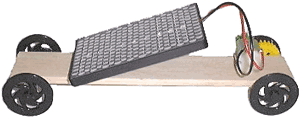 This article has all the information you need to complete a Science Fair Project, including instructional step-by-step video, documentation, required forms, experimentation tips and tricks, and how to squeeze your great idea into the scientific method.
This article has all the information you need to complete a Science Fair Project, including instructional step-by-step video, documentation, required forms, experimentation tips and tricks, and how to squeeze your great idea into the scientific method.[am4show have='p8;p9;p16;p43;' guest_error='Guest error message' user_error='User error message' ] Step 1: Download the Project Guide.
Step 2: Watch the video here...... but note that this video is LOOOOOONG - nearly 2 hours! We just didn't want to forget anything, and we also wanted to give you all the best information we have, so enjoy! (And you'll find that the video intro is the same as the last project's.) If you just want the Solar Vehicles video itself without all the Science Fair stuff, click here for the project-only videos: solar car or wind turbine or solar boat.
Step 3: Download the parts list and data sheet. (You'll need the free Adobe Reader view the PDF files.)
Step 4: Set up and do your experiment.
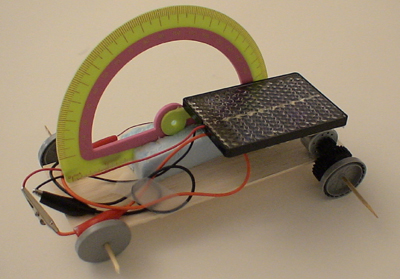
Step 5: Log your data and chart your graphs. OR... download a copy of Excel from Microsoft. Once you have Excel running, use it to chart your data.
Step 6: Write your report. You'll find a sample report in the Project Guide.
Step 7 :Build your display board and exhibit. Find tips & tricks in both the video and the Project Guide. Click here to view the sample display board format. [/am4show]
Download the Unit 5: Energy (Potential and Kinetic) file here.
Don’t forget – we didn’t record this track in a professional studio, so don’t worry if you hear pops, clicks, chimes, or other odd sounds – just focus on the real message and the learning that’s going on. Are you ready??
[am4show have='p8;p9;p36;p63;' guest_error='Guest error message' user_error='User error message' ] Step 1: Download the Project Guide.
Step 2: Watch the video here...... but note that this video is LOOOOOONG - nearly 2 hours! We just didn't want to forget anything, and we also wanted to give you all the best information we have, so enjoy! (And you'll find that the video intro is the same as the last project's.) If you just want the Measuring the Speed of Light video itself without all the Science Fair stuff, click here for project-only video.
Step 3: Download the parts list and data sheet. (You'll need the free Adobe Reader view the PDF files.)
Step 4: Set up and do your experiment.
Step 5: Log your data and chart your graphs. You can get Excel for free at this link. OR... download a copy of Excel from Microsoft. Once you have Excel running, use it to chart your data. Click here for sample Excel file.
Step 6: Write your report. You'll find a sample report in the Project Guide.
Step 7 : Build your display board and exhibit. Find tips & tricks in both the video and the Project Guide. Click here to view the sample display board format. [/am4show]
Aurora will share some of her top secrets with you so you can do the same with your own children. If you set it up right, you will no longer need to push your child to learn, but rather your child will be naturally pulled toward it in a way that lasts long-term. We’ll uncover the ten modes of motivation and the four different types of learning so you can enter your child’s world and meet them at their level, and you will walk away with a game plan for getting the most out of your learning time together.
[am4show have=’p8;p9;p11;p38;p72;p92;’ guest_error=’Guest error message’ user_error=’User error message’ ]
We’ve posted the recording here so you can just play it right on your computer.
Download the How to Motivate Your Child MP3 file here.
Don’t forget – we didn’t record this track in a professional studio, so don’t worry if you hear pops, clicks, chimes, or other odd sounds – just focus on the real message and the learning that’s going on.
[/am4show]
Download the Unit 4: Energy (Pulleys & Levers) file here.
Don’t forget – we didn’t record this track in a professional studio, so don’t worry if you hear pops, clicks, chimes, or other odd sounds – just focus on the real message and the learning that’s going on. Are you ready??
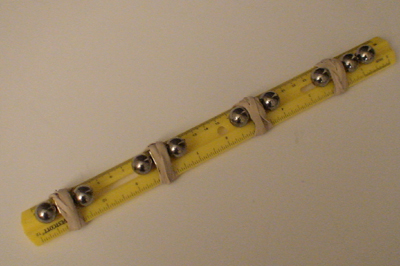 This article has all the information you need to complete a Linear Accelerator (Gauss Rifle) Science Fair Project, including instructional step-by-step video, documentation, required forms, experimentation tips and tricks, and how to squeeze your great idea into the scientific method. Using the principles of momentum and magnetics, you'll build a record-fast accelerator you can fire across the room from the palm of your hand.
This article has all the information you need to complete a Linear Accelerator (Gauss Rifle) Science Fair Project, including instructional step-by-step video, documentation, required forms, experimentation tips and tricks, and how to squeeze your great idea into the scientific method. Using the principles of momentum and magnetics, you'll build a record-fast accelerator you can fire across the room from the palm of your hand.[am4show have='p9;p63;' guest_error='Guest error message' user_error='User error message' ] Step 1: Download the Project Guide.
Step 2: Watch the video here...... but note that this video is LOOOOOONG - nearly 2 hours! We just didn't want to forget anything, and we also wanted to give you all the best information we have, so enjoy! (And you'll find that the video intro is the same as the last project's.) If you just want the Linear Accelerator video itself without all the Science Fair stuff, click here for project-only video.
Step 3: Download the parts list and data sheet. (You'll need the free Adobe Reader view the PDF files.)
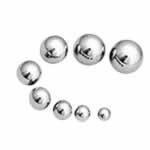
Need parts? Click here to order the magnets and steel ball bearings.
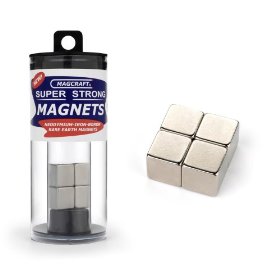
Step 4: Set up and do your experiment.
Step 5: Log your data and chart your graphs. Click here for sample Excel file.
Step 6: Write your report. You'll find a sample report in the Project Guide.
Step 7 : Build your display board and exhibit. Find tips & tricks in both the video and the Project Guide. Click here to view the sample display board format. [/am4show]
Download the Unit 3: Matter (Atoms, Density & Solids) Teleclass MP3 file here.
Don’t forget – we didn’t record this track in a professional studio, so don’t worry if you hear pops, clicks, chimes, or other odd sounds – just focus on the real message and the learning that’s going on. Are you ready??
This webpage has all the information you need to complete a Science Fair Project, including instructional step-by-step video, documentation, required forms, experimentation tips and tricks, and how to squeeze your great idea into the scientific method.
[am4show have='p8;p9;p36;p63;' guest_error='Guest error message' user_error='User error message' ] Step 1: Download the Project Guide.
Step 2: Watch the video here...... but note that this video is LOOOOOONG - nearly 2 hours! We just didn't want to forget anything, and we also wanted to give you all the best information we have, so enjoy! (And you'll find that the video intro is the same as the last project's.) If you just want the Fruit Battery video itself without all the Science Fair stuff, click here for project-only video.
Step 3: Download the parts list and data sheet. (You'll need the free Adobe Reader view the PDF files.)
Need parts? Pick up the electronic parts online including a digital multimeter, alligator test wires, and use a galvanized nail and a shiny penny for the electrodes.
Step 4: Set up and do your experiment.
Step 5: Log your data and chart your graphs. You can get Excel for free at this link. OR... download a copy of Excel from Microsoft. Once you have Excel running, use it to chart your data. Click here for sample Excel file.
Step 6: Write your report. You'll find a sample report in the Project Guide.
Step 7 : Build your display board and exhibit. Find tips & tricks in both the video and the Project Guide. Click here to view the sample display board format. [/am4show]
Download the Unit 2: Mechanics (Velocity & Acceleration) Teleclass MP3 file here.
Don’t forget – we didn’t record this track in a professional studio, so don’t worry if you hear pops, clicks, chimes, or other odd sounds – just focus on the real message and the learning that’s going on.
To get you started, we're turning a previous experiment into a science fair project, so you can see how we've broken down the steps and set up the main framework for turning any project into something worthy of the judge's eye. All the information you need is here to complete a Science Fair Project, including instructional step-by-step video, documentation, required forms, experimentation tips and tricks, and how to squeeze your great idea into the scientific method. Are you ready?
Here's what you need to know: [am4show have='p8;p9;p36;p63;' guest_error='Guest error message' user_error='User error message' ] You'll get to build a rocket powered by a chemical reaction, design your experiment, record data, make a display board, give a presentation, document your progress, chart graphs, write reports, and more with this easy, step-by-step complete science fair project. Let's get started:
Step 1: Download the Project Guide.
Step 2: Watch the video here... but note that this video is LOOOOOONG - nearly 2 hours! We just didn't want to forget anything, and we also wanted to give you all the best information we have, so enjoy!
If you just want the Rocketry video itself without all the Science Fair stuff, click here for project-only video.
Step 3: Download the parts list and data sheet. (You'll need the free Adobe Reader view the PDF files.) Step 4: Set up and do your experiment. Step 5: Log your data and chart your graphs. You can get Excel for free at this link. OR... download a copy of Excel from Microsoft. Once you have Excel running, use it to chart your data. Click here for sample Excel file. Step 6: Write your report. You'll find a sample report in the Project Guide. Step 7 : Build your display board and exhibit. Find tips & tricks in both the video and the Project Guide. Download the sample text for your display board. Click here to view the sample display board format. [/am4show]
Did you know: You can make yellow light from green and red? Oxygen is not flammable? We’ll help you set the record straight and get your year off to a great start with this interactive class for parents. (We’ve found dozens of principles, definitions, and concepts in physical science textbooks that are just plain wrong!)
We’ve posted the recording here so you can just play it right on your computer.
Download the file here.
Don’t forget – we didn’t record this track in a professional studio, so don’t worry if you hear pops, clicks, chimes, or other odd sounds – just focus on the real message and the learning that’s going on.
 Doing science is exciting, fun, and full of big ideas! Why bother with writing when you could be mixing up chemicals, blasting rockets, or shattering laser beams?
Doing science is exciting, fun, and full of big ideas! Why bother with writing when you could be mixing up chemicals, blasting rockets, or shattering laser beams?Because all your "great ideas" are worth nothing if you can't tell others about what you're doing. Scientists write in journals to let others know the latest news with their experiments, announce their new discoveries, or to simply keep track of their progress.
Keeping a science journal doesn't have to be flashy or fancy, just accurate. Science is already hard enough without the added chaos of not knowing what you did yesterday. I'm going to show you the three easy steps to keeping a journal.
You don't have to write a novel - just keep track of what you're doing along with any questions that come up. It's a lot easier to do a couple pages a day for a month rather than trying to pound out a hundred pages in a day! This is something you're going to use throughout the program doing just a little bit at a time, At the end of the month or year, you'll be surprised to see how much science you've covered! [am4show have='p8;p9;p10;p37;' guest_error='Guest error message' user_error='User error message' ]
There are three simple steps to this process:
Grab, Title, and Record
Step 1:Grab a notebook.
You don't need a fancy quad-ruled, glossy bound, gold-letter-embossed notebook, either. Just find a regular spiral-bound notebook from the store and scribble your child's name across the top. (You can even staple ten blank pages together and call it a notebook if you really want to.)Step 2: Title the top of a fresh page with the name of the lesson or experiment.
For example, from Unit 1, you'd write: Gravity. Easy so far, right? Add the date and time to the top corner and number your pages (in case you need to reference them later on. Trust me - it's a lot easier to number as you go).Step 3: Record by describing what you're doing.
 If you're reading about gravity, jot down a few notes about what you picked up. This is where you want to capture your Ah-HA! moments. If getting your child to write is harder than changing a car transmission in a snowstorm, then grab a video camera and record them as they work and talk their way through the experiment. Just have them describe what they are doing as they do it (you can probe them along with questions if they get stuck for words). For shyer kids, don't have them look at the camera - in fact, if you focus the camera only on their hands as they work through an experiment, their shyness usually will vanish.
If you're reading about gravity, jot down a few notes about what you picked up. This is where you want to capture your Ah-HA! moments. If getting your child to write is harder than changing a car transmission in a snowstorm, then grab a video camera and record them as they work and talk their way through the experiment. Just have them describe what they are doing as they do it (you can probe them along with questions if they get stuck for words). For shyer kids, don't have them look at the camera - in fact, if you focus the camera only on their hands as they work through an experiment, their shyness usually will vanish.A lot of scientists and engineers carry around a voice recorder, so when they have a GREAT IDEA, they can quickly capture it with words by hitting the 'record' button (even while driving!). This allows them to quickly capture and talk about the idea without fussing with the slowness of a pencil and paper. They later play it back and jot down notes and expand it when they have more time.
If you love to write and draw, simply write down the experiment or reading bullet points and illustrate with pictures, describing it with real words that make sense to you. Don't worry about it not being 'formal' or 'correct' - this is your journal, not for anyone else.
For example, if you're launching the potato cannon (which we'll actually be doing later on), and you finally figured out how it worked, we'd rather see you write: "I shoved the stick in, which squashed the air, and POP!" instead of "...as the lowermost potato slug was moved in an upward direction, the pressure increased as the volume decreased until the structural integrity of the uppermost potato was breached, at which time the..." Use words that really speak to you in your own terms. You are not writing a textbook, but rather capturing the essence of the experience you're having as you learn science. Got it?
 Also, if you have any questions that pop up along the way (especially ones that require more time to search for the answers), write them down here as well. Highlight or *star* each question so you remember to go back and get them answered when you have more time.
Also, if you have any questions that pop up along the way (especially ones that require more time to search for the answers), write them down here as well. Highlight or *star* each question so you remember to go back and get them answered when you have more time.If you're recording your progress on a science experiment, get your picture taken as you are doing the experiment and paste it in the notebook. Add a caption about what you are doing, what you found, etc. Most scientists will also record any data they took for the experiment alongside the picture of their set up so it's all in one place.
An excellent idea many families have reported using is at the end of the unit, the parents will become the student and the kids teach the lesson back to the parent until the parent gets it. This may take a bit of work of the kid's part, but most of the time, you'll find kids are determined and creative at getting their point across because they are so excited and passionate about what they have just learned. (Don't believe us? Try faking ignorance and see what your child comes up with.)
And that's it! Do you think this is something you can do?
If so, you've just boosted yourself to the top 10% of the students worldwide that actually take the time to capture and record their work. If you just hear or read something only one time, you will only remember 12% of it after about a week. However, when you capture and record notes about what you're doing, the retention after a week shoots up to over 65%. When you take it one step further and teach it to others, you're now over 85% retention after the first month.Turning your Science Journal into Homework You Can Hand In
Once you've mastered the basic steps to keeping a science journal, you can easily match it with your state's requirements for science, provide it as a writing sample with your college application (especially if it contains photos of you taking data), or show it it to your adviser.Writing a Rock-Solid Science Journal Report
Once you've gotten into the habit of Grab, Title, and Record, now it's time to put a little more structure into the 'Record' section. I'm going to share with you how we teach engineering students to keep their lab books at the University. This is the same techniques used by astronomers, automotive designers, nuclear engineers, and NASA scientists.When you use this approach when working through the activities, projects, and experiments in the eScience program, you will have a rock-solid documentation that will pass any curriculum adviser, college-entrance examiner, or state required documentation. And it will be organized, easy to use, and rewarding to flip through years later.
Step 1: Title
The first thing you need is a title. Something that says what you did in ten words or less and describes the main idea. If you ever wanted to transform your experiment into a lab report, your title would have an entire page to itself.In this case, your title area needs to have the title of the experiment, your name (and the names of any helpers that assisted you during your experiment), and the date you performed the experiment (or date range, if your experiment happened over more than a day).
For example:
Effects of Antenna Wire Length on Crystal Radio Reception Aurora Lipper November 23, 2010
Step 2: Introduction (Purpose)
In your science journal, save a half-page to write this later. You won't be able to write it beforehand, as it includes your hypothesis, background information, and summary of how the experiment went. Just leave a spot so you can jot it in later. Keep it simple, straightforward, and only one paragraph. The best thing to include in this section is why you did the experiment.For example:
Which antenna length gives the best radio signal? After researching the electromagnetic spectrum, frequency, wavelength, quartz crystals, and radios, I realized I had all the basics for picking up AM radio stations using simple electrical equipment. But which antenna length would produce the clearest, strongest radio signal in my crystal radio? This radio detects in the AM band that have been traveling from stations (transmitters) thousands of miles away. One of the biggest challenges with detecting low-power radio waves is that there is no amplifier on the radio to boost the signal strength. When designing the experiment, I had to take into account the finer details, such as the width of the wire, whether to use magnet or plastic-insulated wire, the type of diode, and the tube diameter. In addition, I also needed to find an adequate grounding source (I used a metal water pipe) and have enough space to spread out my antenna, which ranged from 10’ to 100’.
Step 3: Materials
What did you use to do your project? Make sure you list everything you used, even equipment you measured with (rulers, stopwatch, etc.) If you need specific amounts of materials, make sure you list those, too! Check with your school to see which unit system you should use. (Metric or SI = millimeters, meters, kilograms. English or US = inches, feet, pounds.)For example:
- Toilet paper tube
- Magnet wire
- Germanium diode (1N34A)
- Telephone handset or get a crystal earphone
- Alligator clip test leads
- 100’ stranded insulated wire (for the antenna)
- Camera to document project
- Composition or spiral-bound notebook to take notes
- Display board (the three-panel kind with wings), about 48” wide by 36” tall
- Paper for the printer (and photo paper for printing out your photos from the camera)
- Computer and printer
Step 4: Procedure
This is the place to write a highly detailed description of what you did to perform your experiment. Write this as if you were telling someone else how to do your exact experiment and reproduce the same results you achieved. If you think you’re overdoing the detail, you’re probably just at the right level. Diagrams, photos, etc. are a great addition (NOT a substitution) to writing your description.For example:
First, I became familiar with the experiment and setup. After raiding Radio Shack for magnet wire, diodes and earphones, I created a simple crystal radio that could detect AM radio waves without the use of a battery. I ran ten trials varying the length of the antenna and estimated the signal strength.
I made myself a data logger in my science journal. I placed the crystal radio in a spot clear from noise, obstructions, and interference from nearby transmitters and connected the ground wire to the metal pipe and strung the antenna along the ground. I then listened to on the earphone and connected up different antenna lengths to get a better feel for judging the scale for signal strength from 1 to 5. Once I finished the pre-tests, I ran ten trials, varying the antenna length in increments of 10’, recording the signal strength with each trial run.
Step 5: Results
This is the data you logged during your experiment. You can leave a page or two to include a chart or graph – whichever suits your data the best, or both if that works for you. Use a scatter or bar graph, label the axes with units, and title the graph with something more descriptive than “Y vs. X or Y as a function of X”. On the vertical (y-axis) goes your dependent variable (the one you recorded), and the horizontal (x-axis) holds the independent variable (the one you changed).| Crystal Radio Data Sheet | |||
| Name | Aurora Lipper | Antenna wire gauge | 24g |
| Date | Nov. 28, 2009 | Tube wire gauge | 28g magnet |
| Time | 12:45pm | Diode type | germanium |
| Trial # | Antenna Length | Signal Strength | |
| (feet) | (Min = 1, Max =5) | ||
| 1 | 10 | 1 | |
| 2 | 20 | 2 | |
| 3 | 30 | 2 | |
| 4 | 40 | 3 | |
| 5 | 50 | 4 | |
| 6 | 60 | 4.5 | |
| 7 | 70 | 5 | |
| 8 | 80 | 5 | |
| 9 | 90 | 5 | |
| 10 | 100 | 5 | |

|
Step 6: Conclusion
Conclusions are the place to state what you found. Compare your results with your initial hypothesis or question – do your results support or not support your hypothesis? Avoid using the words “right”, “wrong”, and “prove” here. Instead, focus on what problems you ran into as well as why (or why not) your data supported (not supported) your initial hypothesis. Are there any places you may have made mistakes or not done a careful job? How could you improve this for next time? Don’t be shy – let everyone know what you learned!For example:
I found that my initial hypothesis (the longer the antenna, the stronger the signal in the crystal radio) was supported by the data, but not in the way I had expected. My best guess was that an antenna of 100’ would produce a clear enough signal to hear distinct words and songs. I found that an antenna length of 60’ and above all gave clear, strong signal results.
For further study, I recommend running an experiment to test the various gauges of wire, tube diameter, and types of grounding sources. This experiment was a lot of fun!
Step 7: References
Every source of information you collected and used for your project gets listed here. Most of the time, people like to see at least five sources of information listed, with a maximum of two being from the internet. If you’re short on sources, don’t forget to look through magazines, books, encyclopedias, journals, newsletters… and you can also list personal interviews.For example: (The first four are book references, and the last one is a journal reference.)
Fox, McDonald, Pritchard. Introduction to Fluid Mechanics, Wiley, 2005.
Hickam, Homer. Rocket Boys, Dell Publishing, 1998.
Gurstelle, William. Backyard Ballistics, Chicago Review Press, 2001.
Turner, Martin. Rocket and Spacecraft Propulsion. Springer Praxis Books, 2001.
Eisfeld, Rainer. "The Life of Wernher von Braun." Journal of Military History Vol 70 No. 4. October 2006: 1177-1178.
Whew! So to recap...
 Step 1: Title: Effects of Antenna Wire Length on Crystal Radio Reception, by Aurora Lipper, November 23, 2010. This goes at the top of the page.
Step 1: Title: Effects of Antenna Wire Length on Crystal Radio Reception, by Aurora Lipper, November 23, 2010. This goes at the top of the page.Step 2: Introduction (Question/Hypothesis/Intro): What effect does antenna length have on an AM band crystal radio? After researching the electromagnetic spectrum, frequency, quartz crystals, wavelength, radio circuitry, sonic vibrations, and how the human ear detects sound, I realized I had all the basics for building a small radio. But which antenna length would produce the best signal? I hypothesized that the longest antenna would give strongest and clearest radio signals. This takes a half page (one paragraph maximum), and is written last. Step 3: Materials: List everything you used in your experiment here. Leave a page for this in case you have to add to it later.
Step 4: Procedure/Experiment: After a quick trip to Radio Shack, I built a crystal radio to test. I ran ten trials varying the type of radio and estimated the signal strength using a sound scale from 1 to 5. Leave two pages for this, one for drawing your experiment out (or snap a photo and insert it here), and the second for writing out what you did and how you set it up. Step 5: Results: Record your data and analyze any numbers. You can add a discussion about what went on during your experiment. Leave a page or two (depending on how many trials you're running) in table form. Test only one thing at a time (the antenna length, in our example), and record what you found.
Step 6: Conclusion/Recommendations: I found that my initial hypothesis (the longer the antenna, the stronger the signal in the crystal radio) was supported by the data, but not in the way I had expected. I found that an antenna length of 60’ and above all gave clear, strong signal results. For further study, I recommend running an experiment to test the various gauges of wire, tube diameter, different types of grounding sources, and types of diodes (such as germanium, zener, and silicon) as each diode cuts the signal strength by a different amount. Leave a page for this section, as you might have to rewrite your conclusion a few times before you get it the way you want it.
Step 7: References: Leave a page for this section, and fill it in as you do your research in the beginning.
Tips & Tricks & Bonus Ideas!
There are a lot of steps to keeping a rock-solid science journal, but once you get into the rhythm, it'll come naturally and you'll actually start to think ahead as you work through your experiment, because you know what you'll need to record to make it worthwhile. One of the things I do is write the seven steps on the inside cover of my journal as a quick reference sheet, so I know how many pages to mark off ahead of time as I write up a new experiment.If I'm starting a fresh notebook, then I'll usually skip the first 5-10 pages before starting to write, and stop writing 5-10 pages before the end. Then I'll go back and add a table of contents in those first skipped pages and an index and/or glossary in the last skipped pages for a more complete book. I'll also number the pages as I go along so this part is a lot easier! Often, I don't take data right in my book, because I make a lot of mistakes and have to rerun the experiment or redo the way I set it up. I'll usually take data on a clean sheet of paper that's got a table marked off, and when I finally get a good run I want to use, I'll tape it into the results page of my notebook.
When I first do a new experiment, I don't record anything at all. In fact, I'll just play with the experiment to get really familiar with how it works, why it works, and what I have to tweak to get it to work just right. The recording process comes after I've rolled around and played with the main ideas. With this approach, I'm able to formulate a better question because now I have experience with the experiment and I find that I am not as worried about making mistakes as I was in the beginning.
Often with an entirely new subject area, I'll have two journals - one is much more informal, and usually titled "My Great Ideas", and the other follows the steps above and is titled "My Science Journal". The "My Great Ideas" is a place for me to write down all the crazy ideas I have before I am ready to record anything, along with any books or media I found that might be useful in doing the experiment, and Ah-HA! moments and all questions that pop up. That way, I've got a spot to brainstorm and come up with experiment ideas before committing it to my more formal write-up book. The great ideas book is usually just for my eyes only, so I don't worry about spelling, neatness, or anything that slows down my creativity.
Download the Unit 1: Mechanics Teleclass MP3 file here.
Don’t forget – we didn’t record this track in a professional studio, so don’t worry if you hear pops, clicks, chimes, or other odd sounds – just focus on the real message and the learning that’s going on.
 The eScience program is appropriate for students grades K-12. You’ll find lots of experiments for students in this entire grade range. Younger students can still work through most of the program with a bit of your help (for using tools and hot glue guns) as they build the robots, laser shows, hovercraft, catapults, roller coasters, chemistry experiments, and much more.
The eScience program is appropriate for students grades K-12. You’ll find lots of experiments for students in this entire grade range. Younger students can still work through most of the program with a bit of your help (for using tools and hot glue guns) as they build the robots, laser shows, hovercraft, catapults, roller coasters, chemistry experiments, and much more.


